

























































Introducing Penick Village’s Newest Expansion, designed to elevate your way of living.
Comfortable Living Spaces: Step into comfort with our 44 beautifully designed Independent Living residences, each thoughtfully crafted to provide you with a home that’s as comfortable as it is stylish.
Village Pavilion: In our state-of-the-art wellness building, you can engage in various activities, including Pickleball, personal training, and an overall focus on your health and wellness.

Comprehensive Healthcare: The Terrace, our health services building, enhanced and renovated, providing exceptional personalized care tailored to your needs.
Welcoming Community: Enter through our updated Welcome House, a space designed to safely welcome you, and your guests, into our community.
Penick Village invites you to join our community, where we’re not just redefining retirement living, we’re elevating it to new heights.
Learn more about our community , where you have the freedom to focus on your wellness and relationships while living life to its fullest . Contact us today. Call (910) 692-0300 , email info@penickvillage1964.org , or scan the QR code to learn more.
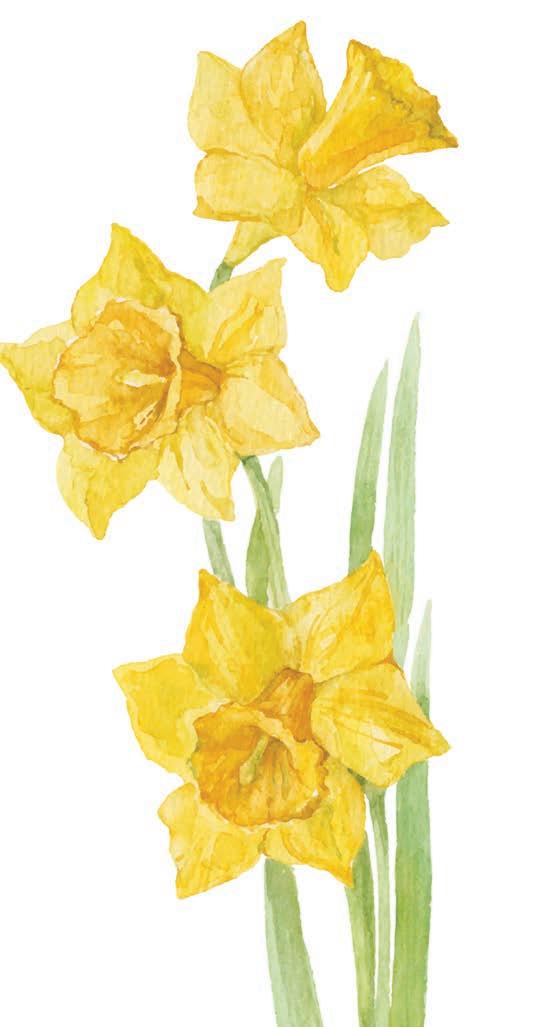
















Thanks to your support, we have won: Best of The Pines 2024 #1 Dealership Service Department. Schedule your appointment today to experience #1 Service





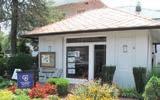

volume 21, No. 3
David Woronoff, Publisher david@thepilot.com
Andie Stuart Rose, Creative Director andiesouthernpines@gmail.com
Jim Moriarty, Editor jjmpinestraw@gmail.com
Keith Borshak, Senior Designer
Alyssa Kennedy, Digital Art Director alyssamagazines@gmail.com
Emilee Phillips, Digital Content emilee@pinestrawmag.com
CONTRIBUTING EDITORS
Jim Dodson, Stephen E. Smith
CONTRIBUTING PHOTOGRAPHERS
John Gessner, Laura L. Gingerich, Diane McKay, Tim Sayer CONTRIBUTORS
Jenna Biter, Anne Blythe, Tom Bryant, Susan Campbell, Bill Case, Tony Cross, Brianna Rolfe Cunningham, Mart Dickerson, Bill Fields, Tom Maxwell, Mary Novitsky, Lee Pace, Todd Pusser, Joyce Reehling, Deborah Salomon, Scott Sheffield, Rose Shewey, Angie Tally, Kimberly Daniels Taws, Daniel Wallace, Ashley Walshe, Claudia Watson, Amberly Glitz Weber
ADVERTISING SALES
Samantha Cunningham, Advertising Director 910.693.2505
Kathy Desmond, 910.693.2515
Terry Hartsell, 910.693.2513
Erika Leap, 910.693.2514
Christy Phillips, 910.693.2498
Ginny Trigg, 910.693.2481
ADVERTISING GRAPHIC DESIGN
Mechelle Butler, Scott Yancy PS
Henry Hogan, Finance Director 910.693.2497
Darlene Stark, Circulation Director 910.693.2488
SUBSCRIPTIONS 910.693.2488
OWNERS
Jack Andrews, Frank Daniels III, David Woronoff
In memoriam Frank Daniels Jr.
145 W. Pennsylvania Avenue, Southern Pines, NC 28387 www.pinestrawmag.com
©Copyright 2025 Reproduction in whole or in part without written permission is prohibited. PineStraw magazine is published by The Pilot LLC










Moore County’s Most Trusted Real Estate Team!

CARTHAGE • $249,900
1410 GRACIE LANE
Nice two-story 3 BR / 2.5 BA Townhome in Carriage Place subdivision. This energy efficient end-unit would be a great investment opportunity.

ABERDEEN • $479,900
519 N. SYCAMORE STREET
Beautiful newly constructed 4 BR / 2.5 BA move-in ready two-story home. Layout is bright and open with nice finishes throughout. All 4 bedrooms and 2 baths on upper level.

PINEHURST • $475,000
6 GREENBRIER LANE
Charming 3 BR / 2 BA golf front home in popular No. 6 community! Floorplan is bright and open with nice views of the course across the back. Just a short walk from the Clubhouse and driving range.

PINEHURST • $382,000
130 LOST TREE ROAD
Situated in the desirable Lake Pinehurst area, this 3 BR / 2 BA home is perfect for a family, a place to retire or a golf retreat. The layout is spacious with nicely remodeled kitchen!

ABERDEEN • $449,900
515 N. SYCAMORE STREET
Beautiful newly constructed 4 BR / 2.5 BA move-in ready two-story home. Layout is bright and open with nice finishes throughout. All 4 bedrooms and 2 baths on upper level.

PINEHURST • $499,900 70 SAWMILL ROAD E.
Wonderful 4 BR / 2.5 BA new construction in Village Acres! Home is incredibly light and open on the main level while bedrooms and laundry room are hosted on the upper level.


ABERDEEN • $478,900
525 N. SYCAMORE STREET
Nice 3 BR / 2.5 BA NEW CONSTRUCTION close to downtown Aberdeen. Layout bright and spacious with LVP flooring in main living area and quarts countertops in kitchen.

CARTHAGE • $235,000
556 STAGE ROAD
Cozy 1 BR / 1 BA Cottage that comfortably sleeps four. Located in a quiet spot just outside of Carthage this would be the perfect investment property or great golf getaway!

SEVEN LAKES WEST • $450,000
172 MORRIS DRIVE
Delightful 4 BR / 3 BA home in beautiful 7LW location. Home has been nicely updated to include remodeled kitchen, new flooring and has been freshly painted!
IN MOORE COUNTY REAL ESTATE FOR OVER 20 YEARS!

Moore County’s Most Trusted Real Estate Team!

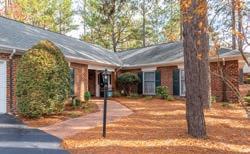
PINEHURST • $1,100,000 47 KILBRIDE DRIVE
Impressive 3 BR / 2.5 BA golf front home located off the 4th green of the Magnolia course in prestigious Pinewild CC. Main level boasts over 3,900 sq.ft. where rooms are spacious with lots of windows, most with sweeping golf views, beautiful hardwood flooring throughout and a great kitchen.


PINEHURST • $1,110,000 133 ST. MELLIONS DRIVE
SOUTHERN PINES • $552,000 10 RAVENEL COURT Immaculate 3 BR / 2.5 BA custom golf front home in quiet National/Pinehurst No.9 location. Almost 3,000 sq.ft. on one level, with fine finishes throughout as well as stunning golf views.
appliances. Lock and leave and in great condition.



SOUTHERN PINES • $880,000 1906 MIDLAND ROAD
Stately 4 BR / 3 Full BA, 2 half BA two-story home with hardwood floors in main living area, beautiful kitchen and spacious primary suite on the main level. Upper-level hosts 3 additional bedrooms and a nice oversized bonus room. A must see!



PINEHURST • $1,575,000 125 GRAHAM ROAD
New construction underway! 5 BR / 4 BA home situated on a corner lot in historic Old Town Pinehurst. Convenient to the heart of the Village of Pinehurst and its quaint shops, pubs and the Pinehurst Resort.

Howell’s Masonry recently helped remove the historic cornerstone from The Village Chapel in Pinehurst in anticipation of the 100 year anniversary of its first worship service on March 1, 1925.
by Jim dodsoN
If you live long enough, the saying goes, you will discover that healing takes time.
This ancient wisdom is being driven home to me because 15 days before I sat down to write this column, I received a complete left knee replacement.
Friends who’ve been down this path were quick to assure me that the pain and discomfort that accompanies major joint surgery can only be mitigated by time, patience and committing to an aggressive program of physical therapy.
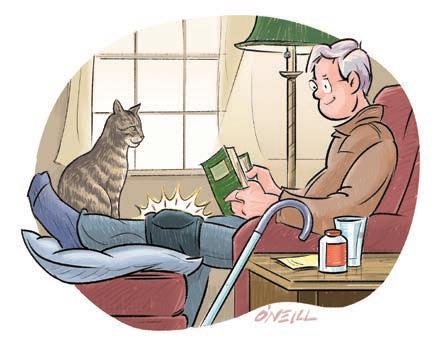
Owing to a lifetime of sports injuries and a fulsome style of landscape gardening my cheeky bride, Wendy, once called a “blood sport with bushes and trees,” I suppose I’ve always downplayed my naturally high tolerance for pain — until now.
“Did you happen to catch the number of the city bus that ran over my leg?” I groaned to my wife on post-op day three, often described as the peak moment of pain during joint recovery.
“Just relax and let your body heal,” was her response. “By March, you’ll be back in the garden and playing golf with a brandnew knee that feels great. It just takes some time to heal, babe.”
Of course, she was right. So, I shut my yap and let my body get on with its healing business without further interference from me.
It proved to be a wise move. Upon completing my second week of physical therapy, not only did I learn that I was a week and a half ahead of the normal recovery rate from knee replacement, but had also begun to regain the ability to walk without the assistance of a cane. The pain was also slowly vanishing — so much so that I did a walking tour of my garden to assess the winter damage.
This adventure got me thinking about how waiting for the pain to stop and the healing to begin is a common experience that touches every aspect of our lives.
As children, we fall down or cut a finger and run to Mom or
Dad, who applies the bandage and a kiss that makes the injury soon forgotten.
Every day on the news, however, we learn about children who live in war zones or are victims of child abuse. Their young lives will forever be damaged by the trauma they’ve suffered — a pain that will likely never quite vanish, leaving a wound that may never heal.
On a much larger scale, the recent devastation of homes and lives lost from Hurricane Helene and the raging wildfires of Los Angeles have produced pain and suffering on an apocalyptic scale, something that will take decades for communities to rebuild and heal. The outpouring of love and assistance from complete strangers to our mountain neighbors, however, speaks volumes about our shared human instinct for healing. A similar outpouring is already underway in the City of Angels.
On the scale of normal, everyday life, a lover’s broken heart may only require a few healing months of intense self-care, a good therapist and a new pair of shoes to begin the mending process.
The psychic pain of losing a job, sending a child off to college, ending a close friendship, or saying goodbye to a loved one or special place you may never see again can impose their own unique weight on the human heart. In time, only memory and gratitude for what was may soften the pain.
That, at least, is my hope.
One evening over this past Christmas, as we sat by the fire watching a holiday movie, our beloved cat, Boo Radley, suffered a sudden massive seizure. Boo was a large, gray tiger cat who entered our lives 14 years ago when Connor, Number Two son, brought him home as a tiny feral kitten found at the Southern Pines train depot on a winter night.
Connor named him “Nico” and kept him in his upstairs bedroom for several weeks before he moved on to Boston to accept a new job. At that point, we renamed the inherited young cat “Boo Radley” and watched him quickly take over the house. One min-
ute he was grooming the ears of our big golden retriever, Ajax, the next sleeping in kitchen pots and pans. He was always up to some amusing mischief that made us all smile.
For some reason, Boo took a particular shine to me, showing up at my desk every morning to playfully tap my computer keys as I wrote. The first time I let him outside, he followed me entirely around the backyard watching me plant roses and mow the lawn.
One summer evening near dusk, I saw Boo bolt across the backyard being chased by a young gray fox. Before I could come to his rescue, I saw the young fox running back the other way — chased by Boo. Crazy as it sounds, their game of tag went on for weeks.
When we moved to the old neighborhood where I grew up in the Gate City, Boo really found his stride. He supervised as I re-landscaped the entire property and faithfully came to sit under the trees with me every afternoon when the day’s work was done. Likewise, for over a decade, he never failed to appear from his nighttime rounds to sit together under the early morning stars while I sipped coffee and had a friendly chat with the universe. He usually snuggled up in my lap as the Almighty and I sorted things out. On most afternoons, he napped in the golden-hour sun in his favorite part of the garden, which I eventually named “Boo’s Garden.”
Like the original Boo Radley, he particularly didn’t care for strangers, and proved to be fiercely territorial, ready to chase off any feline intruder foolish enough to get too close.
Wendy liked to say Boo was simply guarding his turf — and his best buddy.
I do believe this may be true.
On the fourth night after my knee replacement, however, during the deepest pain of my recovery, Boo suffered his sixth seizure in five weeks. The promising medication he’d been on for a month simply didn’t work, proving the art of healing is as much mystery as it is science.
Following a sleepless night, we made the painful decision to end Boo’s suffering. Hours later, a lovely vet from Lap of Love came and put my best pal to sleep on his favorite blanket. I don’t think I’d ever felt such emotional pain. Over a cat, no less.
Every moment of this life, as my late Grandmother Taylor liked to say, someone is waiting beneath a clock for a birth or a death or a chance to begin again.
The return of spring brings winter’s long wait to an end. It’s nature’s moment to heal and begin again.
With my brand-new knee, I can’t wait to get out into the garden.
But my best friend is gone, a pain that will probably take years to heal. PS
Jim Dodson can be reached at jwdauthor@gmail.com. His 17th book, The Road That Made America: A Modern Pilgrim Travels the Great Wagon Road, will be published by Avid Reader Press and is available for pre-order on Amazon.


45 CHESTERTOWN DRIVE - FOREST CREEK
Prestigious gated community. Top of the line throughout, wine cellar and much more.
$2,950,000 - GOLF FRONT

New construction. High end, open floor plan, game room, first floor Master Suite.
$1,395,000 - OLD TOWN

84 POMEROY DRIVE - PINEWILD
Desirable Pinewild, overlooks Gary Player designed 5th green, all brick, quality custom.
$899,000 - PINEWILD

8 INTERLACHEN LANE - PINEHURST NO 6
Floor to ceiling windows, family room, fireplace, Carolina room, heated and cooled workshop.
$699,000 - PINEHURST NO 6

112 ERIN HILLS - PINEHURST
Pinehurst NO 5, expansive and multiple golf views, high end renovation, electric fireplace.
$464,000 - GOLF FRONT
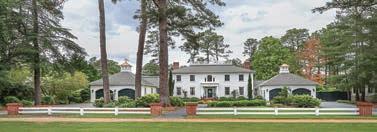
255 CHEROKEE ROAD - PINEHURST
Old Town Historic Village. Totally renovated, separate mother-in-law suite. 4 car garage.
$2,295,000 - OLD TOWN

535 DONALD ROSS DRIVE - PINEHURST
Custom brick home, large open sun filled rooms, hardwood floors, deck, pond, private.
$995,000 - DONALD ROSS DRIVE

160 THUNDERBIRD LANE - GOLF FRONT
Pinehurst NO 5, private, mid modern, accordion glass doors, Bertazzoni appliances.
$730,000 - SOLD

509 COTTAGE LANE
Soaring ceilings, large open spaces, natural light floods every room, Carolina room, deck.
$549,000 – PENDING
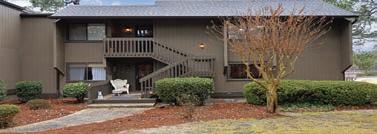
201 LAKEVIEW - PINEHURST



The Country Bookshop, 140 N.W. Broad St., Southern Pines will be hosting Ada Calhoun as she discusses her novel Crush, on Wednesday, March 12, from 6 to 7 p.m. Then, on Wednesday, March 19, also from 6 to 7 p.m., Eddie Huffman will be in the bookshop to talk about his recent release, Doc Watson: A Life in Music. More information and tickets can be obtained at www.ticketmesandhills.com.

Wee Bit o’ the Green
Pinehurst turns the whole village green when the Irish take to the streets for the annual St. Patrick’s Day Parade on Saturday, March 15, beginning at 10 a.m. If you put your folding chair down at James W. Tufts Memorial Park, 1 Village Green Road W., you won’t miss a single leprechaun. For more blarney go to www.vopnc.org.


Have a problem with old age? The great Garrison Keillor is here to provide a little perspective. Despite its inconveniences, old age brings the contentment of “less is more.” Your mistakes and big ambitions are behind you. There’s nothing left to prove. And small things give you great pleasure because, well, that’s what’s left. “Garrison Keillor Tonight” is an evening of wit, storytelling, audience song and poetry on Friday, March 28, at 8:30 p.m. on the main stage of Owens Auditorium in the Bradshaw Performing Arts Center, 3395 Airport Road, Pinehurst. The show features sonnet singing, limericks and musical jokes. And there’s news from Lake Wobegon, a town booming with new entrepreneurs, makers of artisanal firewood and gourmet meatloaf, breeders of composting worms, and dogs trained to do child care. Age aside, there are some things that endure, and Garrison Keillor is one of them. For additional information and tickets go to www.ticketmesandhills.com.
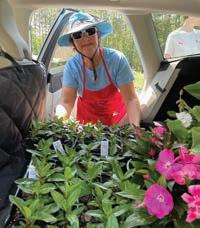
Bring a blanket or a folding chair and a picnic basket, kick back and listen to saxophonist Sarah Hanahan outdoors on the lawn from 2 p.m. to 4 p.m. at the Weymouth Center for the Arts & Humanities, 555 E. Connecticut Ave., Southern Pines, on Sunday, March 23. There will be a cash bar with mimosas, beer, wine and non-alcoholic offerings. For info see www. weymouthcenter.org.
The Pinehurst Garden Club wants your sunny disposition, water, a little fertilizer and for you to buy their plants during the annual garden pre-sale that runs from March 16 to April 10. You can check out the flower options and order online at pinehurstgardenclub. org, or by contacting a member. The pickup is Sunday, April 27, at the Green Haven Farm, 255 Green Haven Lane, Carthage. Just drive up and pop the trunk. The sale supports two students in the horticultural studies program at Sandhills Community College.

Mira USA, a national nonprofit organization providing guide dogs to blind children ages 1117, will host its annual Mira-cles Happen Gala on Saturday, March 8, at 6 p.m., at the Country Club of North Carolina, 1600 Morganton Road, Pinehurst. Guests will have the chance to meet two 2024 guide dog recipients: 12-year-old Elijah with his guide dog, Maple, and 15-year-old Shaelin with her guide dog, Guiro. The evening includes a gourmet dinner, live music and entertainment, along with silent and live auctions. Individual tickets and sponsorship packages are available by visiting www.miraevents.org/miracles-happen-gala.

If your salute to the old sod lasts longer than just St. Patrick’s Day, grab a seat for Andy Clooney’s Irish Celebration on Tuesday, March 18, from 7 to 9 p.m., at the Fair Barn, 200 Beulah Hill Road S., Pinehurst. The show features Ireland’s comedy duo Mick Thomas and Sean Finnerty along with The Emerald Fire Irish Dancers backed by the Guinness Irish Band. For information and tickets go to www.cooneyshows.simpletix. com. Cheers.
The Garden Club of the Sandhills will host its 2025 “Blooming Art” exhibit featuring professional floral designers, local garden club members and local artists on Saturday, March 29, from 10 a.m. to 4 p.m., and on Sunday, March 30, from noon to 4 p.m., at the Campbell House, 482 E. Connecticut Ave., Southern Pines. Tickets are good for either day. For information go to www. ticketmesandhills.com.


Kids ages 3 – 12 can celebrate the arrival of spring at the Spring Fling in the Downtown Park, Southern Pines, on Friday, March 28, from 5:30 to 7:30 p.m. The afternoon festivities include games, face painting and bounce houses, and will be followed by an outdoor movie, Moana 2. Concessions will be available for purchase. For additional information call (910) 692-7376.
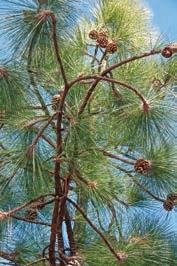
The Party for the Pine, the festival celebrating the oldest longleaf pine in the world, will be from 10 a.m. to 3 p.m. at the Weymouth Woods Boyd Tract meadow, Weymouth Woods, 555 E. Connecticut Ave., Southern Pines, on Saturday, April 5. The celebration features games, food trucks, turpentine demonstrations, lessons on the native habitat and, weather permitting, a live prescribed burn. For additional information call (910) 692-2167.

(February 19 – March 20)
In case you need the reminder: Yellow does not mean gun it. And only a Pisces needs to hear that it doesn’t mean drift into oblivion, either. Proceed with caution, yes. But stay the course. Be aware of your surroundings and navigate accordingly. When Venus goes retrograde on March 27, it’s time to tend a karmic wound before it festers. In other words: Identify the pattern so you can break it. When in doubt, a salt bath ought to help.
Aries (March 21 – April 19)
Scrap the old story.
Taurus (April 20 – May 20)
Opt for the silk ones.
Gemini (May 21 – June 20)
Steady your hand.
Cancer (June 21 – July 22)
Keep on keeping on.
Leo (July 23 – August 22)
Don’t miss your cue.
Virgo (August 23 – September 22)
Too much salt will wreck the meal.
Libra (September 23 – October 22)
Cast a wider net.
Scorpio (October 23 – November 21)
Get some fresh air.
Sagittarius (November 22 – December 21)
Try washing behind your ears.
Capricorn (December 22 – January 19)
Fix your gaze on the horizon.
Aquarius (January 20 – February 18)
Plant the seed, then let it be. PS
Zora Stellanova has been divining with tea leaves since Game of Thrones’ Starbucks cup mishap of 2019. While she’s not exactly a medium, she’s far from average. She lives in the N.C. foothills with her Sphynx cat, Lyla.











MORTGAGES IN ALL 50 STATES

By Stephen e . Smith
If you believe the ancient Romans had little to do with your life, look at your feet. They gave us the concept of left and right footwear. They also left us their checkered history, of which there’s too damn much. If you’ve tackled Gibbon’s unabridged The History of the Decline and Fall of the Roman Empire, you know that a manageable history of ancient Rome requires a framing device that places events and characters in perspective.
Historian/numismatist Gareth Harney has devised an agreeable gimmick. He has selected what he believes are the 12 most significant coins minted during the Empire’s 800-plus years, and he’s written A History of Ancient Rome in Twelve Coins, connecting the coinage to the emperors and events that influenced their minting.

Roman coins were struck from alloys of gold, silver, bronze, orichalcum or copper — materials that gave them resilience — and they are discovered still in Welsh fields and Polish barnyards. You can buy a pile of uncleaned Roman coins on eBay for $30.
First introduced in the third century BCE, Roman coins were used well into the Middle Ages, and during a denarius’ existence, it would likely have passed between millions of hands. Many of the coins are worn smooth, obscuring the profile of the emperor or god whose likeness was meant to ensure political stability and economic security.
In crisp, energetic prose, Harney opens each chapter as if he were writing historical fiction. “The vision was surely his alone,” he writes of Constantine’s moment of conversion. “Yet the confused shouts of his soldiers seemed to claim otherwise. As the marching column ground to a halt before the spectacle, men raised their arms to the clear sky, calling out to their emperor
to witness the unfolding miracle. It took shape, by all accounts, in the rays of the midday sun. A glowing halo surrounding the solar disk, sparkling with additional rival suns where it was intersected by radiating horizontal and vertical beams — all shimmering like jewels with spectral color.”
Harney guides the reader through the history of Rome from Romulus, suckled by a wolf on an early Roman coin, to the last emperor, who was deposed by the German general Odoacer in 476 CE. In the early years of the Empire, coins illustrated mythical scenes and various gods and goddesses, but that changed, as did much of Roman life, when Julius Caesar issued coins bearing his likeness. “Even in an age of giants — Pompey, Cicero, Antony and Cleopatra — Caesar would tower above all,” Harney writes, “bestriding the world like a colossus.” The appearance of Caesar’s profile on the Roman denarius in 44 BCE is acknowledged as a transformative moment in Roman history. The new coin violated ancient law, tradition, and the sacred delineation between military and civic authority. Caesar went so far as to order the minting of a denarius with the likeness of the defeated Gallic leader Vercingetorix, an enemy of the Roman Republic.
The Julio-Claudian dynasty receives its due — Tiberius, Caligula, Claudius, Nero, Vespasian, et al. — and Harney explains the events leading to the coinage produced by each emperor. Bits and pieces of Roman excess and debauchery are reviewed in tolerable detail, and readers are occasionally treated to new depravities, of which there was no shortage in an empire populated with leaders who were murdered almost as quickly as they took power.
For many of these upstart emperors, assassination was often a merciful escape. In 260 AD, for example, the emperor Valerian was defeated by King Shapur I and was taken prisoner. He lived out his years in slavery, falling to his hands and knees to act as a step for Shapur to mount his horse. The emperor of Rome had become a human footstool for an enemy king who later had him

« March 9, 7:00 pm
Live from the Great Room: Grace McNally Trio
March 23, 2:00 pm
«
Come Sunday Jazz Series: Sarah Hanahan
Also, this month at Weymouth Center:
March 13, 3:30 pm
Writer-In-Residence Reading: John Amen
March 16, 2:00 pm
Young Musicians Festival
March 17, 9:30 am
Women of Weymouth: Andie Stuart Rose, PineStraw Magazine
March 18, 2:00 pm
James Boyd Book Club: Poster Girl by Meredith Ritchie
March 22, 10:00pm
Spring Into Reading!
March 25, 6:00 pm
Song Circle Jam Session


Scan the QR code for tickets and additional information!
555 East Connecticut Avenue, Southern Pines, NC

skinned, stuffed and placed on display.
Harney’s discussion of the various currencies makes the constant shuffling of Roman emperors slightly less confusing, but the devaluation of Roman coinage is his most significant and timely lesson. The emperors, unable to pay for Rome’s defense, lessened the amount of silver or gold in each coin. “By 270, the ‘silver’ coins of Rome held less than 2 percent precious metal. Nothing more than crude scraps of copper rushed out of the mint, without a thought of quality control. A thin silver wash on the coins only served to insult the intelligence of the Roman people, and quickly wore off to reveal the depressing base metal below.” Any belief in a reliable gold or silver standard vanished from the monetary system. As coinage ceased to hold its value, Romans returned to barter as a method of exchange. When new coins were issued, they dulled more quickly, and they felt light in the hand, signaling debasement. Each degraded coin is part of the puzzle whose final piece reveals the complete collapse of the Roman state.
A History of Ancient Rome in Twelve Coins will appeal to a broad audience. Excluding the rare reader who has a comprehensive knowledge of Roman history and the numismatist specializing in Roman coinage, the majority of readers (those who saw an episode or two of I, Claudius or the movie Gladiator) will find Harney’s history well-written, informative and sophisticated — high-end Monarch Notes for Gibbon’s six-volume Decline and Fall. They may even feel inspired to start collecting Roman coins.
Harney doesn’t claim that his research offers profound insights into our contemporary political divisions or the teetering state of our democracy, but readers will likely infer whatever lesson appeals to their politics. One truth, however, is inescapable: Empires rot from the inside out. PS
Stephen E. Smith’s most recent book, The Year We Danced: A Memoir, is the recipient of a 2025 Feathered Quill Book Award.


















Count My Lies, by Sophie Stava

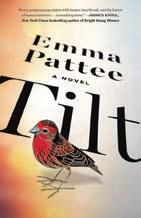

career, and her anxiety about having a baby. If she can just make it home, she’s determined to change her life.
Wild Dark Shore, by Charlotte McConaghy
Sloane Caraway is a liar. Harmless lies, mostly, to make her self-proclaimed sad little life a bit more interesting. So when Sloane sees a young girl in tears in the park one afternoon, she can’t help herself — she tells the girl’s (very attractive) dad she’s a nurse and helps him pull a bee stinger from the girl’s foot. With this lie, and chance encounter, Sloane becomes the nanny for the wealthy and privileged Jay and Violet Lockhart — the perfect New York couple, with a brownstone, a daughter in private school, and summers on Block Island. But maybe Sloane isn’t the only one lying, and all that’s picture-perfect harbors a much more dangerous truth. The thing about lies is that they add up, form their own truth and a twisted prison of a world. Be careful what you lie for.
The River Has Roots, by Amal El-Mohtar
In the small town of Thistleford, on the edge of Faerie, dwells the mysterious Hawthorn family. There, they tend and harvest the enchanted willows and honor an ancient compact to sing to them in thanks for their magic. None are more devoted than the family’s daughters, Esther and Ysabel, who cherish each other as much as they cherish the ancient trees. But when Esther rejects a forceful suitor in favor of a lover from the land of Faerie, the sisters’ bond and their lives will be at risk.
Tilt, by Emma Pattee
Annie is nine months pregnant and shopping for a crib at IKEA when a massive earthquake hits Portland, Oregon. With no way to reach her husband, no phone or money, and a city left in chaos, there’s nothing to do but walk. Making her way across the wreckage of Portland, Annie experiences human desperation and kindness: strangers offering help, a riot at a grocery store, and an unlikely friendship with a young mother. As she walks, Annie reflects on her struggling marriage, her disappointing
Dominic Salt and his three children are caretakers of Shearwater, a tiny island not far from Antarctica. Home to the world’s largest seed bank, Shearwater was once full of researchers, but the Salts are now its final inhabitants until a woman, Rowan, mysteriously washes ashore. Long accustomed to protecting herself, Rowan starts imagining a future where she could belong to someone again, but she isn’t telling the whole truth about why she set out for Shearwater. And when she discovers sabotaged radios and a freshly dug grave, she realizes Dominic is keeping his own secrets. They all must decide if they can trust each other enough to protect the precious seeds in their care and if they can finally put the tragedies of the past behind them to create something new, together.
Raising Hare: A Memoir, by Chloe Dalton
In February 2021, in the English countryside far away from her usual London life, Chloe Dalton stumbled upon a newborn hare — a leveret — that had been chased by a dog. Fearing for its life, she brings it home, only to discover how impossible it is to rear a wild hare, most of whom perish in captivity from shock or starvation. Through trial and error, she learns to feed and care for the leveret with every intention of returning it to the wilderness. Instead, it becomes her constant companion, wandering the fields and woods at night and returning to Chloe’s house by day. Though Chloe feared that the hare would be preyed upon by foxes, stoats, feral cats, raptors and even people, she never tried to restrict it to the house. Each time the hare leaves, Chloe knows she may never see it again. Raising Hare chronicles their journey together, while taking a deep dive into the lives and nature of hares, and the way they have been viewed historically in art, literature and folklore.

Sunrise on the Reaping, by Suzanne Collins
The long-awaited fifth book in the runaway bestselling “Hunger Games” series, Sunrise on the Reaping, arrives this month. As the day dawns on the 50th annual Hunger Games, fear grips the district of Panem. Twice as many tributes will be taken from their homes. When you’ve been set up to lose everything you love, what is there left to fight for? (Ages 14 and up.)




Over in the Garden, by Janna Matthies
There are fun books and cute books. Then there are books that will become part of the family canon. Over in the Garden has the makings of a family classic. Counting, color and compost are rounded out with a delightful repeatable rhyme. This one is perfect for Earth Day or any nature-loving family. (Ages 2-6.)
Little Freddie Two Pants, by Drew Daywalt


First it was crayons, and now its pants. Author of The Day the Crayons Quit takes the everyday and makes it ridiculous! Perfect as a read aloud, this picture book will have young readers dreaming up all the new ways of putting on pants. (Ages 2-6.)
The Cranky-Verse: Cranky Chicken Book 4, by Katherine Battersby
Cranky Chicken, a kid favorite in the early graphic novel section, is back for another adventure with three hilariously cranky stories about Cranky Chicken, Speedy the Worm and their new friend, a little turtle. Join them on a set of illustrated adventures as they learn how to take care of each other, navigate a cranky injury, and go on a camping adventure. (Ages 6-9.) PS

Compiled by Kimberly Daniels Taws and Angie Tally













By Bill FieldS

Not long after Sara E. Johnson and I began a recent phone call, I couldn’t resist reminding my Pinecrest High School classmate what she had penned a long time ago in my senior yearbook.
“When you’re a rich and famous news man and I’m a rich and famous news lady,” she wrote on a back page in my Spectrum, “let’s get together and talk over old times.”
The words were the earnest well-wishes from one eager aspiring journalist to another. Sara LeFever and I were on the staff of The Courier, the student newspaper, for a couple of years, and officers in the Quill and Scroll club. We alternated weeks reporting high school news in The Pinehurst Outlook, with fresh-faced class pictures as our respective column sigs.
Neither of us fulfilled the futures mentioned in her message. I gravitated to sports, specializing in golf coverage. A stay-at-home mother of three until earning a master’s degree from UNC and becoming a reading specialist in her 40s, Johnson contributed articles on family and education to newspapers in Chapel Hill and Raleigh.
When we talked in January, the conversation didn’t revolve around our high school days (although we agreed it can be tough to review examples of our early, raw writing) but rather newer, exciting developments in Johnson’s life, which should be an example for anyone of a certain age.
“I was 60 when my first novel came out in 2019,” she said. “People need to know it’s never too late.”
Johnson’s debut book, Molten Mud Murder, was the first installment in the “Alexa Glock Forensics Mystery Series.” The central character is a plucky and slightly geeky American investigator living in New Zealand, a traveling forensic who uses teeth to solve
crimes. The debut has been followed by The Bones Remember, The Bone Track, The Bone Riddle and The Hungry Bones. The final book in the series, Bone Chilling, will be published this year.
The mysteries resulted from the nine months Johnson and her husband, Forrest, who live in Durham, spent exploring New Zealand in 2014. After returning home from a fascinating land that had intrigued her greatly, she pursued the notion of writing a book, something I had encouraged her to do in an email when we reconnected more than 20 years ago. “You said if you want to write a book, you can do it,” Johnson said. “Your message really stuck with me.”
Johnson has always been a wide reader, including mysteries. She has been enamored of the genre since she was 10 and read The Bungalow Mystery, a Nancy Drew book given to her mother in 1942. She spent a year writing Molten Mud Murder. Then came the hard part, which required much patience and persistence.
“I think I had 66 rejections from literary agents, but then the 67th came along,” Johnson said. “I don’t know where the cutoff would have been. Would I have contacted 75 or 100 agents? I don’t know. I was getting some positive rejections — people saying, ‘I like this and this, but don’t like that.’ What I call the positive rejections kept me going, and I kept honing the manuscript.”
Johnson informs her books with meticulous research provided by a cadre of professionals to ensure accuracy in her scenes. “I have wonderful experts who read over what I’ve written,” she said. “One forensic pathologist can spend two pages telling me how to flip a body on an autopsy table.”
At work on her seventh book, revolving around a coroner in northern Minnesota, Johnson will incorporate the forensics knowledge she gained producing the Alexa Glock series. She tries to write 1,000 words a day while relying on important assessments along the way from fellow writers.
“Hands down, the biggest help for me is being in a writers’ group,” Johnson said. “We meet weekly, not just mystery authors but folks in all kinds of genres. We bring 10 pages, read them, and people critique them. Reading your work aloud and getting good feedback is so valuable. I can’t thank them enough.”
As for others who might want to tap into their creative side later in life, Johnson believes it isn’t a mystery. “Sit down and do it,” she said. “If you have a dream to write a book, it’s possible.” PS
Southern Pines native Bill Fields, who writes about golf and other things, moved north in 1986 but hasn’t lost his accent.


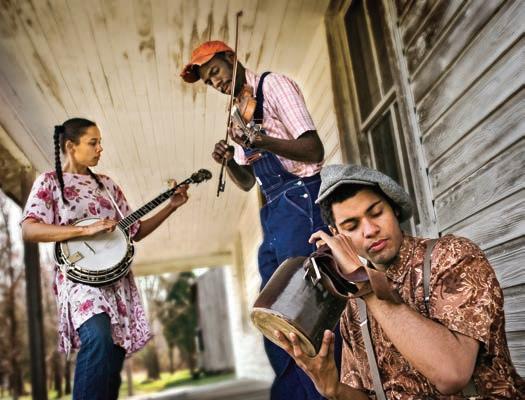
By tom m axwell
It all started in April 2005, at the first “Black Banjo: Then and Now Gathering.” The event, held at Appalachian State University in Boone, was part scholarly pursuit and part throwdown, featuring four days of “lectures, jams, workshops, down home frolics, and performances” with a view to bringing the “funky, plunky instrument” back home to Black America. Dom Flemons, a 23-year-old student at Northern Arizona University, attended.
“I was the young person at the event,” Flemons says. He had been playing banjo for a few years already, busking on street corners and devouring records by the Memphis Jug Band and Dave Van Ronk, as well as ’20s songster music of people like Gus Cannon, who had a late-in-life hit when the Rooftop Singers covered his 1929 stomper “Walk Right In,” and Henry Thomas, whose Texas ragtime tunes were covered by ’60s folk/rock stal-
warts Bob Dylan, The Lovin’ Spoonful and the Grateful Dead, among others.
So, like many young people who fall in love with old music, most of Dom’s musical heroes were dead — even if their music was very much alive. But in Boone he was about to enter the musical land of the living.
“When I met Joe Thompson, a light bulb went off in my head,” Flemons says. “I heard him playing at the opening ceremony for the Black Banjo Gathering, and all of a sudden I understood the music that connected people like Henry Thomas to Gus Cannon. When I heard Joe’s music, I heard that flavor of fiddle and banjo music that these guys were referencing, playing and living next to generationally. And that inspired me to move out to North Carolina. I sold everything I owned, packed up my car, and took Route 66 east, headed for North Carolina to be near the music.”
Thompson, born in 1918, had been playing African American string band music for 80 years by the time Dom Flemons heard him perform at the Black Banjo Gathering. An Orange County native, Thompson joined his family on fiddle (after studying his father’s old-time technique, which was handed down by his own father, a former enslaved person) playing square dances, parties
and dances after corn shucking or tobacco stripping. Joe considered quitting music after his cousin and musical partner, Odell Thompson, died in the ’90s, but picked it back up basically by popular demand. Even a stroke in 2001 couldn’t slow him down. “I got to sit with Joe and play music,” Flemons remembers, “and it was a powerful experience just to be in his presence. I also tried my best to play banjo behind his fiddle playing. I knew that I was connected to the tradition from there.
Every morning that you wake up in a pest-free home is a good morning. And the easiest way to ensure that stress-free feeling?
Sign up for Bug Out’s Year-Round Pest Protection Plan+ service!

“There’s magic in the excitement and drama and the wealth of culture that is translated through a live performance,” Flemons adds. “It’s something beyond just music. It’s a feeling as well and, if you’re deep in the culture, you understand the nuances of that feeling. In the ’50s, they talked about old-time music and analyzed it a certain way. So, when you read books about it, you can understand it to a degree. But once you’re in it, that’s when you can take on a whole other quality.”
Two years after his performance at the first Black Banjo Gathering, Joe Thompson became a National Endowment for the Arts National Heritage Fellow. He also started mentoring Dom Flemons’ new band. Local musicians Rhiannon Giddens and Justin Robinson also saw Thompson at the Black Banjo Gathering and had been playing music at his Mebane house for several months by the time Dom, newly graduated from college, moved to North Carolina. The three youngsters decided to form a band of their own. “These are the years leading into Obama being elected,” Flemons says, “and culturally, people were ready for a Black string band. They could handle it.”
Flemons, Giddens and Robinson called their band the Carolina Chocolate Drops. “With the combination of all three of the original members of the trio, we created a sound that was very authentic and raw, but also landed right,” Flemons says. “I always compare it to The Beatles because we had a gestation period where we mostly played square dances. So, we always had a rock solid rhythm. I leaned 100 percent into that, because being a fan of the Grateful Dead and stuff like that, I understand that give and take with the audience.”
All traditions, an accomplished jazz musician once observed, meet at the root. In their career, the Carolina Chocolate Drops were seamlessly able to blend Civil War-era Black string band music, ’60s folk-rock, jazz and hip hop. It’s no surprise — but still an absolute delight — that the band covered Blu Cantrell’s 2001 R&B Top 40 hit “Hit ’Em Up Style (Oops!)” on their Grammywinning album Genuine Negro Jig.
“I was a fan of Old Crow Medicine Show,” Flemons says, “so I always thought about fast old-time as being a genre. Fast old-time is something that people have always enjoyed, and it was becoming very popular at that time. When we were arranging songs with the Carolina Chocolate Drops, they would usually do a Joe Thompson number. I came up with the jug and took a combination of what I thought about with traditional jug bands, as well as people like Charles Mingus, and applied that to ‘Georgia Buck.’ There were parts I came up with that were a Charles Mingusinspired type of bebop bass lines. That gave us a unique sound
from a traditional old-time string band.”
The Carolina Chocolate Drops went on to have a stellar career, releasing five albums, opening for luminaries like Taj Mahal and Bob Dylan, making numerous television appearances, and performing several times at the Grand Ol’ Opry. But as all fiery combinations do, they burned bright, then out. Robinson left in 2011; Flemons followed suit two years later. By 2014, the group functionally disbanded. Until now.
“Rhiannon wants us to do this festival she’s putting together, Biscuits & Banjos,” Flemons says. The festival will be held in Durham April 25 - 27th and will feature not only a reunited Carolina Chocolate Drops, but also solo appearances by Flemons and Giddens. Rounding out the stellar lineup are legacy acts like Taj Mahal, promising newcomers Infinity Song, Tar Heel native Shirlette Ammons and many more. In the tradition of the Black Banjo Gathering — and countless others since time immemorial — there will be artist talks, workshops, a biscuit bake-off (Giddens is a self-described “avid biscuit baker”) and a community square dance. The festival website characterizes the event as “dedicated to the reclamation and exploration of Black music, art and culture in North Carolina.”
Indeed, all American musical traditions do meet at the root. Blues, jazz, rock-and-roll — and a sizable chunk of country music — owe their very existence to African American musical idioms and
cultural expressions. We are all the better for it, and when you combine this history with Southern food and an old-school hootenanny, life gets very good indeed. And North Carolina is one of the few places in America where something like this could happen.
“North Carolina is such a wellspring of culture in general,” Flemons says, “and I believe that it has done a lot of things right when it comes to expressing the culture of the state. It is one of the very first states, so it has a deep history. There’s a lot of different musicians coming out of North Carolina — they’re doing traditional music but also jazz and gospel. I think it’s something in the way that the land is structured and the way people are raised. Because a lot of times they have this particular connection to the land, and a foot in both the country and the city. That is very unique.
“The Carolina Chocolate Drops did school shows in almost every city and town in North Carolina, so I got to see everything from Edenton all the way up to Asheville and Black Mountain and Hot Springs. Every part of North Carolina has something beautiful and unique, and the music reflects that.” PS
Tom Maxwell is an author and musician. A member of Squirrel Nut Zippers in the late 1990s, he wrote their Top 20 hit “Hell.” His most recent book, A Really Strange and Wonderful Time: The Chapel Hill Music Scene 1989-1999, was published by Hachette Books.














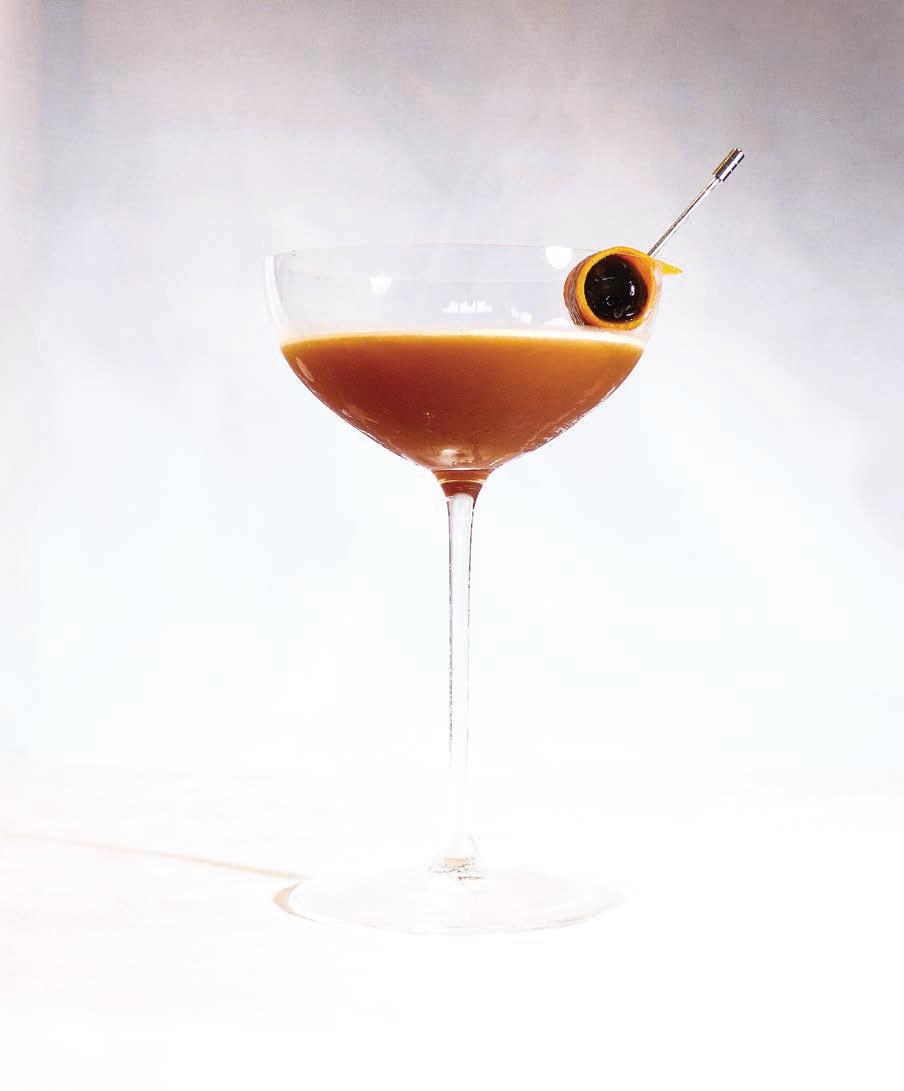
By tony CroSS
I hereby present to you a cocktail that I’ve never really enjoyed: the “Blood and Sand.” Well-known to bartenders, it’s a relatively unknown classic cocktail to drinkers. Even though the creator of this cocktail is a mystery, it originally appeared in Henry Craddock’s The Savoy Cocktail Book in 1930. The Blood and Sand takes its name from the 1922 silent film Blood and Sand, starring Rudolph Valentino. The movie follows a matador, Juan Gallardo, whose rise from poverty to become one of Spain’s greatest bullfighters ends in tragedy, romantic betrayal and death.
On paper, the ingredients for the cocktail don’t seem to make sense: equal parts Scotch whisky, cherry Heering, sweet vermouth and orange juice. Admittedly, it does taste better than the specs would lead you to believe. The problem, as I saw it, is that it has never tasted great. Enter acid-adjusted juices. Adding citric and malic acids to juices like grapefruit, orange and pineapple allows you to have one juice in the mix instead of two. More juices means more dilution, means more of a balancing act with your sweetener and alcohol.
When I learned of acid-adjusting from bartender Dave Arnold, one of the first drinks I thought of was the Blood and Sand. Orange juice on its own is missing that citric punch, something that this drink is lacking. Ingredients are meant to be toyed with, and by playing around with these specs, we can take a drink that is just OK to a drink that’s really good. You’ll also notice that I do away with “equal parts” as I up the amount of whisky.
Specifications
1 1/4 ounce Scotch whisky (do not use one that is over-peaty)
3/4 ounce acid-adjusted orange juice*
1/2 ounce cherry Heering
1/2 ounce sweet vermouth
Execution
Combine all ingredients into a cocktail shaker, add ice, and shake hard for 10-15 seconds. Strain into a chilled cocktail coupe. Garnish with orange peel and brandied cherry.
*Acid-adjusted orange juice: per 100 ml of fresh orange juice, mix in 5.2 grams of citric acid. PS
Tony Cross owns and operates Reverie Cocktails, a cocktail delivery service that delivers kegged cocktails for businesses to pour on tap — but once a bartender, always a bartender.

p hotograph and Story By roSe Shewey
It’s strawberry o’clock somewhere
Eating seasonally makes for an interesting lifestyle. The practice of only buying and eating foods that are grown locally and harvested at peak flavor is a worthy undertaking but also a commitment I’m not ready to make just yet. I can easily enjoy locally harvested foods all summer long, especially in North Carolina, where we grow an abundance of exciting warm weather crops — but I don’t foresee myself mastering the art of exclusively eating root vegetables and canned goods for months on end during the winter.
I do have some principles, though. These past few months at the grocery store, I had to use all my power of persuasion to talk my 6-yearold out of bagging strawberries that were grown thousands of miles away and, frankly, a bit pale and sorry looking. So, that’s a “no” to buying imported berries, as well as “winter tomatoes,” the epitome of blandness. On the other hand, I have a hard time turning down avocados from south of the border, or especially plump and juicy-looking citrus from across the country, if the opportunity presents itself.
In the case of the strawberry, which is native to Northern America, it makes a lot of sense to wait for the local harvest. Not only will the berries look better, they’ll be their most nutritious and aromatic. But here again, I fall off the wagon by stretching the term “locally grown.” As soon as the first strawberries harvested anywhere in the Southeast hit the shelves, all bets are off.
So, come March — the month I typically start noticing Florida-grown strawberries in the markets — we’re in the strawberry business, just a few weeks before our (truly local) Sandhills strawberries are ready to be picked. To bridge the gap between the cold season and the tender beginnings of spring, I like to prepare a strawberry fruit salad and mix in wintry grapefruit. Make it into a meal and serve this fruit salad with waffles. A grain- and gluten-free almond and oat waffle is the ideal accompaniment to this fruity affair — and not just for breakfast.
Fruit Salad
(Serves 4)
2 grapefruit, peeled
400 grams strawberries
2 tablespoons strawberry syrup or other liquid sweetener (optional)
Dice grapefruit (peel off the membrane, if desired) and slice the strawberries. Add cut fruit to a bowl and toss with strawberry syrup or sweetener of choice. Refrigerate until ready to use.
Almond Oat Waffles
(Makes 4-6 waffles)
1 cup oat flour
1 cup almond flour
3/4 teaspoon baking powder
Pinch of salt
3/4 cup milk (nut milk or whole milk)
2 tablespoons honey (softened) or granulated sugar
3 eggs
2 teaspoons vanilla extract
3 tablespoons butter (melted) or coconut oil
Preheat your waffle iron. Combine oat flour, almond flour, baking powder and salt in a bowl and whisk to combine. In a separate bowl, whisk together the milk, honey or sugar, eggs, vanilla extract and butter. Pour the dry ingredients into the wet ingredients and stir until well combined. Ladle batter into your waffle iron and cook until golden and slightly crisp. PS
German native Rose Shewey is a food stylist and food photographer. To see more of her work visit her website at suessholz.com.





By ruth mooSe
these days are driving me OOMM. Out of my mind. There is a new one every day. Prolific as mosquitoes, they buzz around and are joined by others, both old and new, like some strange alphabetic mating ritual.
“BRB,” I heard someone say. “What?” I asked. “Be right back,” she repeated for my benefit, with just a hint of pity in her voice. They’ve cracked the seal on print and text and have invaded speech, turning it into a game of Hangman.
The acronyms of my youth came from postal letters: PS added after a signature meant “postscript” to signify an additional thought. Is this the granddaddy of them all? The AOA? The Australopithecus of acronyms? I remember notes and letters that ended with the acronym SWAK. “Sealed with a kiss.” Oh, how sweet. And even later still, letters signed TSTSA: “Too sweet to sleep alone.” Naughty, naughty.
Next thing I know it’s OMG everywhere I looked. Oh My God. I admit, I heard that one before I saw it. LOL. That one showed up in an email. Lots of love? Lots of luck? Oh, right. Laugh out loud.
Are we really so busy with texts and emails that the entire word has been rendered obsolete? Reader’s Digest (RD to you), a stalwart American institution of reasonably good taste, recently devoted a whole page to . . . acronyms, replacing the page usually devoted to vocabulary. Codes taken from everywhere, every day. Acronyms that most everyone would (or should) know: TBD (to be determined); ESL (English second language); GMO (genetically modified organism); ROM (range of motion); SPF
(sun protection factor); TMI (too much information). I thought I was getting the hang of it until I got to SEP (someone else’s problem) and the last one on the page, JGI. JGI?
Just Google it.
It seems every profession has its own acronyms. Real estate ads have WICs — walk in closets. Book reviewers have ICPID — I couldn’t put it down. Wedding planners never know what to do with the MOG — mother of groom.
Lurking in our everyday, text-heavy world are ones like FWIW (for what it’s worth) or ICYMI (in case you missed it). There is even an online magazine by that five-letter name. Poor thing. Personally, I’d rather spell it out like National Geographic. And, oh, wouldn’t I love to go back in Time?
If an acronym has you totally stumped and you have to ask someone, you might as well paste the scarlet L (thumb and forefinger) on your own forehead — Loser. Face it, you’re hopelessly OOTL (out of the loop). Horrors. You may, from time to time, come across someone who will laugh kindly and decode the acronym for you. This is a WW (win-win). You get to go on your way with a brand new bit of alphabet slang to hang on your belt and then part company with the satisfaction of having behaved like the Good Samaritan.
Recently I sent an email responding to an upcoming event I planned to attend. At the end I added LW.
My recipient fired back, “What is LW?”
Lord Willing.
I thought everybody knew. PS
Ruth Moose taught creative writing at the University of North Carolina-Chapel Hill for 15 years and tacked on 10 more at Central Carolina Community College.

The clutch that says it all

By deBorah Salomon
Back in the 1940s, radio personality Art Linkletter would go through women’s purses, creating profiles based on what he found.
He was usually spot-on. Sometimes embarrassing, always hilarious.
Not sure if the Smithsonian has a nook devoted to purse profiles. If not, maybe it oughta make room for this revealing artifact. But instead of a dive into contents, I’ll extrapolate information from the purse itself, notably what sets it apart from ancestors.
In a word . . . compartments.
Some ladies like ’em inside, others prefer the exterior. Notice that both interior and exterior may or may not have zipper, snap or Velcro closures. Some side compartments are narrow with no closure, designed to stash eyeglasses but prone to losing them. Others, square and flat, accommodate a tablet.
No, not the kind with lined yellow pages.
Most women designate one compartment for lipstick and a comb. “Compacts” are so Art Deco, along with bright red lipstick and loose powder. Nothing dates a purse more than a skinny flip-phone compartment . . . except maybe the material it’s made from.
Back in the day, ladies’ winter handbags were hand-held leather of various grades, from coarse cowhide to fine calfskin. Queen Elizabeth II set the style. Call it grandmotherly. Spring meant shiny black patent leather. Come summer, you switched to straw or quilted cotton. The advent of vinyl/plastics resulted in stiff imitation leather adorned with brassy bling. They were big and heavy, even empty. A worse affront: designer knockoffs,
an insult to YSL, Louis Vuitton and Chanel, sold on Manhattan street corners. But they did establish one rule: A brown YSL goes with any color outfit.
As for shape/size, shoulder bags took over when women ditched the bridge club for a business forum, a court hearing, surgery schedule or middle-school soccer game. Princess Diana put clutches on the map, primarily to hide her cleavage when emerging from a Rolls. A shoulder bag that left hands free to text Chinese take-out became roomy enough to stash leotards for a workout on the way home from the office.
Contents, or the lack thereof, offer another readout. Here’s what you won’t find in the modern woman’s handbag: a checkbook; cigarettes and lighter; a wad of “emergency” cash; Chiclets; a single-function car key; an address book; a rain bonnet; movie ticket stubs; a Neil Diamond CD; a map; a pencil; bobby pins; stamps; a tiny metal aspirin container; a handkerchief; a safety pin for the dreaded bra strap malfunction.
How come only men carry handkerchiefs?
Speaking of men . . . remember the man bag, which made a splash in the 1990s? Before the invention of pockets, Renaissance noblemen carried coins in “girdle pouches” without incurring ridicule. And a 5,000-year-old mummy named Ötzi the Iceman was found in the Alps beside his purse. No such luck for 20th century gents when, as I recall, even a plain leather crossbody drew giggles.
These days, the most coveted clutch might be a little thing hardly big enough for an iPhone, designed by Judith Leiber, who isn’t above wrapping a snake around black sequins and charging a few thousand for it at Bergdorf’s.
Now if only I didn’t need four new tires . . . PS Deborah Salomon is a contributing writer for PineStraw and The Pilot. She may be reached at debsalomon@nc.rr.com.



By SuSan CampBell
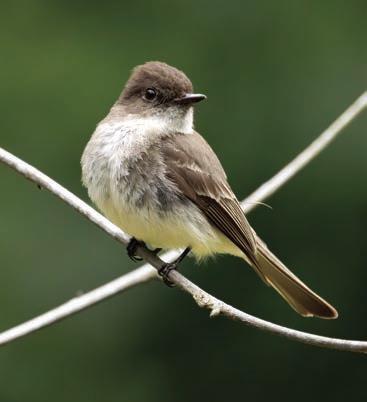
Eastern phoebes are small black and white birds that can be easily overlooked — if it wasn’t for their loud voices. Repeated “fee-bee, feebee” calls can be heard around wet areas all over our state. The farther west one travels through the Piedmont and into the foothills of North Carolina, calling males become more and more evident. From March through June, males declare their territory from elevated perches adjacent to ponds and streams. Even on warm winter days, these little birds can be heard loudly chirping or even singing a phrase or two.
Phoebes have an extensive range in the U.S., from the East Coast to the Rockies, and up and across central Canada. In the winter they can be found in Southern states from the Carolinas over to Texas down into Mexico and northern Central America. They are exclusively insectivorous, feeding on beetles, dragonflies, moths — any bugs that will fit down the hatch. Although they do not typically take advantage of feeders, I have seen one that did manage to negotiate a suet cage one winter. Because their feet are weak, they’re not capable of clinging, so this bird actually perfected a hovering technique as it fed in spurts.
Originally eastern phoebes utilized ledges on cliff faces for nesting. We do not know much about their habits in such locations since few are found breeding in those places now. Things
have changed a lot for these birds as humans have altered their landscape.
While phoebes can be easy to locate as a result of their loud calls, in our area their nests may not be. Although they are goodsized open cup structures, they will be tucked into out-of-the-way locations. Typically, they will be on a ledge high up on a girder under a bridge or associated with a culvert. They may also be up in the corner of a porch or other protected flat spot. Grasses and thin branches are woven and glued together with mud to form the nest; therefore it’s critical that the location be close to water.
The affinity eastern phoebes have for nesting on man-made structures in our area may indicate that these are safer than more traditional locations. Climbing snakes are not uncommon in the Sandhills. Black rat snakes and corn snakes are not as active on buildings as they are on bridges and other water control structures. The phoebes may be adapting their behavior in response to these predators and others less likely to be found so close to human activity.
If you have, or have had, phoebes on your property in summer, I’d like to hear about it. I continue to record locations and details on nesting substrate for the species in the Sandhills. The variety of locations that these little birds choose has been very curious. Light boxes and fixtures, gazebos, porch support posts and more have been used, if they are covered by at least a slight overhang. Not only is water a necessity for phoebes in summer, but they require mature trees for perching and foraging as well. Keep an ear out and perhaps you will find one of these adaptable birds nearby — and be sure to let me know! PS
Susan Campbell would love to hear from you if you have interesting bird observations to share. Contact her at susan@ncaves.com



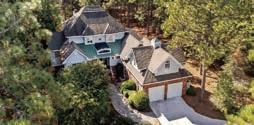



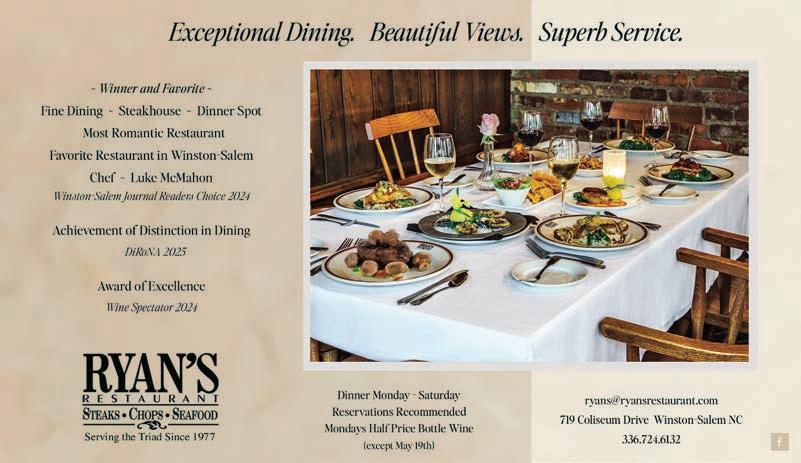
By tom Bryant
It was one of those cold, gray, wet late winter days that reinforced the groundhog’s prediction of six more weeks of bad weather. I was up in the roost, the little apartment over our garage where I go to write or go through damp duck hunting gear in preparation for storing it until next season. It’s also a great place to make plans for hunting, fishing or camping trips. On this day, though, I was just sorting through some old journals that I began many years ago.
There was a little female cardinal huddled on a dogwood branch right outside the window next to my desk. If the window had been open, I could have reached out and touched the little bird. Her feathers were puffed up as if she had on a fluffy down vest. She looked in at me with one eye closed as if to say, “Man, it’s cold out here.” I watched for a couple of minutes until she flew away, and then I picked up one of my journals.
I started keeping hunting diaries, sometimes daily, sometimes weekly, back in the late ’70s. It was the same time I started a newspaper, and during the unpropitious years of the Carter recession, I was constantly trying to generate enough revenue in advertising to pay the folks working for me. One of the first journals I started was right in the middle of those tumultuous times when every work week was a struggle. One entry reads: “January 20, George came by and wanted to know how business was doing. I told him to keep his fingers crossed that I would have the bank payment next week.” George was my banker at Wachovia, before they were taken over by Wells Fargo during their own hard times. The loan was on money I had borrowed to help start the paper. Interest, 8 percent, floating. Before the loan was settled, I was paying 21 percent to my good friend George and Wachovia Bank.

hunting, fishing and camping experiences, dates, weather and other observations. Brief and to the point.
The missives are stacked in the bookcase in no particular order, so I glanced briefly at the year and moved on. One thing I discovered was that my years always started in March, not January. The seasons for hunting, fishing and camping described my yearly doings. A good example: March was the planning month, a time to put away hunting gear and get ready for fishing. Spring would be turkey hunting and camping, hiking and more fishing. In the summer, July and August brought along more laid-back camping and fishing. September, October, November, December, January and February were for bird hunting, duck hunting and late fall surf fishing. Then comes March and the cycle starts again.
Some of the journals have more entries than others, and some are right eloquent in describing the events of the day, such as “Shot three Canada geese while Bryan was parking the truck.” Or, “Bryan stepped in over his waders in the marsh at Hester’s. As he was falling, he hollered, ‘I’m going in.’” Hester’s duck hunting club at Mattamuskeet is one of the finest in the country. We hunted there numerous times and got a lot of fun out of Bryan Pennington, a good hunting buddy.
Another entry was set in motion by my good friend and sidekick John Vernon. It read, “When we paddled up the river to the location of the Haw River blind, it was gone.” Off and on the summer before the fall duck season, John and I had built the finest duck blind on the lake. A major rainstorm, right before legal duck shooting, washed the blind downriver and we never saw it again. We still laugh about that, vowing never to waste time on a permanent blind again.
I chuckled to myself. “Reminder, never borrow money to start a newspaper.” The newspaper remained viable, along with other ancillary businesses, for 17 years before it was sold and I escaped the responsibility of a weekly payroll.
The journals I started during that period mostly pertained to
I continued to browse, and remembering the recent snow, pulled out the one from January 2000. That was the month of what became known as the great blizzard. According to the notes I made, over 28 inches of snow fell. And that led to the first ever bulldog edition of The Pilot
Moore County was a disaster. The snow started early that




Beautifully Framed Art is the
Accent your walls with reflections of your unique style through the unlimited custom picture framing design choices at The King’s Custom Framing.
• Honor that Special Occasion wrapped in a Custom Frame
• Preserve Great Golfing Moments
• Protect and Display Special Military Achievements and Memories
Create the perfect frame design for the things you love.









afternoon, forecast to be only 4 to 5 inches. Publisher David Woronoff and I met at lunch when the snow first started falling, and he decided to let the employees go home early before it got too deep. Little did we know that the weather people had totally missed it. That night we were smothered in sleet, ice and snow.
The writing in the journal continued, “Pine trees down everywhere, had a hard time getting to the office.” I was the only one at the paper who had a four-wheel drive vehicle, and after trying different routes, I found one that wasn’t blocked by fallen trees. David also made it, along with a few other much-needed employees. He decided to put out a bulldog edition (old newspaper jargon meaning a rare and very infrequent publication, usually before the regular printing). It detailed the disastrous results of the storm.
Our carriers couldn’t deliver the paper, so we split up the county. Dennis, our circulation director, took the area toward Pinehurst. David, Southern Pines and nearby hotels and motels. I did the same toward Aberdeen, and we hand-delivered the four-page section. I ended that episode of the journal, “No power for 6 days.”
The journals rolled right along until last year. My grandfather always told me there were no bad times in life. It just depended on how you interpreted them. I believed that until 2024. For me, there is no redeeming factor in that annum.
One bad time after another followed me that year. First, a knee replacement. A good call in the end, but recovery time was longer than I anticipated. My brother passed away after a linger-

ing deadly disease, then I was diagnosed in late summer with a debilitating aliment that would lay me low for several months and put a crimp in my lifestyle.
It turns out that my granddad was right, though. After I changed my attitude about my sickness and began looking at it like an adventure, things started to fall in place.
I met wonderful folks, health care professionals and patients. The health care industry deserves a feature all its own, and someday I plan to write that story. The patients, what can I say? Never before have I run across such optimism and value of life.
A great example was the afternoon we were leaving after an appointment. Linda was outside the hospital getting the car from valet parking, and I was sitting on a bench inside the lobby. A wheelchair rolled up beside me with a shrunken old man holding on with some apprehension. He and I talked. He was from New Zealand and was getting ready to head home on a morning plane. He had a wonderful smile, and after a short conversation, he and his caregiver headed for the sliding door. I wished him well.
“No worries,” he said. “Me and Jesus be mates.”
On the last page at the end of the empty journal I had designated for 2024, I added the caption. “To Be Continued.” PS
Tom Bryant, a Southern Pines resident, is a lifelong outdoorsman and PineStraw’s Sporting Life columnist.










Pictured left to right: Rick Palmer, Senior Vice President/Investments, CoBranch Manager; Richard Palmer, Jr., CFP®, Financial Advisor; Windy Pratt, Senior Registered Client Service Associate; Bill Eastman, CFP®, Senior Vice President/Investments, Co-Branch Manager; Wendy Schmidt, Registered Client Service Associate; Bailey Vaughan, CFP®, Vice President/Investments
DONATIONS UP TO $50,000 BY JULY 2025 WILL BE DOUBLED THANKS TO
Forbes’ Best-in-State Wealth Management Teams rankings are based on the 12-month period ending March 31 of the year prior to publication and selected by SHOOK Research, LLC from a pool of nominations as indicated in the methodology.The rankings may not be representative of any one client’s experience and are not indicative of the financial advisor’s future performance. For more information, see www.stifel.info/award-disclosures.
Stifel, Nicolaus & Company, Incorporated Member SIPC & NYSE | www.stifel.com


By lee paCe
On the fourth Saturday in March, a banquet will be held in a room at the Pinehurst Resort to inaugurate two new members of the Carolinas Golf Hall of Fame: David Eger and Don Padgett II. The venue is appropriate to the honorees because it’s just a quick stroll down the weathered steps of the clubhouse to the first tee of the No. 2 course, where Eger won the Donald Ross Junior as a 17-year-old and the North & South Amateur as a 38-year-old, and where Padgett competed in the PGA Tour’s one-anddone 144-hole World Open in 1973.
It’s also a golf course on which both left an indelible administrative imprint — Eger in helping reintroduce No. 2 to the world of competitive golf in the 1990s, and Padgett for his vision to suggest and then oversee the Coore & Crenshaw renovation in 2010-11.
“David was a key voice in the USGA’s decision to take the 1999 U.S. Open to Pinehurst,” says David Fay, the USGA executive director from 1989-2010. “He is someone whose opinions on golf courses were taken most seriously by me and others at the USGA.”
“Don created the vision for restoring No. 2 to is original state, an incredibly gutsy undertaking for a course that had hosted two very successful U.S. Opens,” says Mac Everett, the chairman
of the Presidents Council that led corporate sales efforts for the 2014 U.S. Open and U.S. Women’s Open at Pinehurst. “But his vision was only a start. There remained the planning, execution and completion of the project. This is where Don excelled.”
The Carolinas Golf Hall of Fame is an august body comprised of crack golfers from the South Carolina coast (Beth Daniel) to the North Carolina mountains (Billy Joe Patton) to the Sandhills (Peggy Kirk Bell). There are professionals (Raymond Floyd to Betsy Rawls), amateurs (Harvie Ward to Estelle Lawson Page), architects (from Donald Ross to Tom Fazio), club professionals (Dugan Aycock to Gary Schaal) and administrators (Richard Tufts to Hale Van Hoy). In general, two to three new honorees are recognized every other year.
It’s not at all by design but rather providential timing that two with such deep connections to Pinehurst should be recognized one year after Pinehurst staged its fourth U.S. Open, and its first with the sparkling new USGA Golf House Pinehurst and World Golf Hall of Fame buildings sitting in the backdrop.
When Pinehurst and its owner Bob Dedman Sr. were digging their way out of the Diamondhead bankruptcy messiness in the 1980s, Eger remembers the resort presenting itself to the PGA Tour, hat in hand. He was five years into his career with the tour, running tournaments and serving as a rules official, and two of his mentors had deep Pinehurst roots — P.J. Boatwright, who ran USGA competitions, and Clyde Mangum, who lived in Pinehurst in the mid-1900s while running the CGA as executive director.
One day in 1987, Eger got a call from Ron Coffman, the longtime managing editor of Golf World magazine (published







in Southern Pines at the time) who was also friends with Don Padgett Sr., who had just been appointed director of golf at Pinehurst.
“Ron invited me to come up and play No. 2 with him and Padge,” Eger says. “I had always thought of Pinehurst as a wonderful, wonderful place, but obviously it fell on hard times for a while. We were playing the course and Padge assured me if the Tour was interested, they would bend over backward to do anything within reason to have another event. Lo and behold, we were looking down the road for a new spot for our Tour Championship. Pinehurst in late October, after it had cooled off and the bent was healthy and firmed up, would be a perfect spot.”
Eger was impressed with everything he saw and heard and reported back to PGA Tour Commissioner Deane Beman. That’s how the 1991 Tour Championship came to be, with Craig Stadler beating Russ Cochran in a playoff for the title. Eger looked at the leaderboard during the final round and noted that only Stadler and Cochran were in red numbers.
“Two players under par,” he mused. “That looks like a U.S. Open.”
A portend of things to come, no doubt.
Well
Certified Robotic GYN Surgery
Infertility Treatment
Intrauterine Insemination
Continence Evaluation and Treatment
Menopause Health Management
National Certified (AIUM)
Gynecological Ultrasounds
Femilift
Hormone Replacement Therapy and
Fay was in Pinehurst that week, closely inspecting the logistics, the course, the accommodations, the traffic, the galleries and the overall ambience. He came away with a thumbs-up. He believed a U.S. Open at Pinehurst could be “Tracyand-Hepburnesque, a match made in heaven.” That week led to the announcement less than two years later that the USGA would stage the 1999 U.S. Open at Pinehurst.
“The players loved Pinehurst, but not all of them loved the golf course,” Eger says of that first Tour Championship. “So many didn’t understand this was a golf course where you did not necessarily shoot right at the pin to get the ball close. You had to play these undulations and angles. The sooner they understood that the better. If they refused to buy into that philosophy, they were not going to score well. It was a







difficult thing for players accustomed to taking dead aim at a pin to have to aim 30 feet away.”
Padgett II watched all of this from a distance as he was running the golf operation and later the entire resort at Firestone Country Club through the early 2000s. His father retired at Pinehurst in 2002, and two years later longtime CEO Pat Corso left to establish a club management firm. Padgett II became Pinehurst’s new CEO. He kept a low profile during the 2005 Open, all the prep work having been done before his arrival, but he watched and listened closely.
Padgett, a man who had played three years on the PGA Tour, shot a 66 in the third round of a U.S. Open and kept close ties with current players, had quite the sharp eye. He was struck by how much the buzz about the golf course seemed to have quieted between Pinehurst’s first and second U.S. Opens.
“The difference between ’99 and ’05 was amazing,” Padgett says. “So much of what you read and heard in ’99 was how great the golf course was. But in ’05, you didn’t hear that.”
Over the next three years, Padgett came to believe that narrowing the fairways of No. 2 and allowing the rough to grow had stripped the course of the essence of the Sandhills and obscured the similarities in the landscape that architect Donald Ross had drawn to his homeland in Scotland. The final nail was playing No. 2 with Lanny Wadkins in June 2008 and Wadkins ripping
the course as being a shell of what it was during its so-called “golden era” of the mid-1900s.
That gave Padgett the confidence to suggest to owner Bob Dedman Jr. they flip the palette from the lush green look everyone coveted in golf to a haphazard display of hardpan sand and wire grass, gnarly edged bunkers and fairways watered only with a single-row irrigation system. The work by Coore & Crenshaw began in February 2010 and was complete 13 months later.
Eger, who left golf administration in the late 1990s to play the PGA Champions Tour — collecting four tournament wins there — was among the first golfers to play No. 2 in March 2011 after the course had been closed all winter
“The distinction between grass and the sand is wonderful,” he said. “It’s the way golf courses from the golden age looked. Pinehurst had that distinctive look of the scrub rough areas and wire grass. Putting it back took a lot of courage, but ultimately it was the right thing to do.”
The modern age of Pinehurst No. 2 is 40 years in the making. The Carolinas Golf Hall of Fame is properly saluting two of its major protagonists. PS
Lee Pace has chronicled the evolution of Pinehurst and the No. 2 course since the late 1980s. Write him at leepace7@gmail.com and follow him @LeePaceTweet.










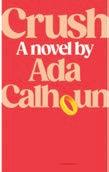
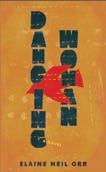








When I was thirteen, my grandmother gave me an opal ring. I like to wear it when I dress up to go out. It is so delicate most people never notice it. My grandmother whispered, It’s from some old beau.
I wear the ring, her memory, to feel magical. Three small iridescent stones, a gold band worn thin. Only when I asked did she whisper her secret. Did you ever look deeply at the displays of color,
opaque stones holding quiet fire? The band’s worn thin. The last time you betrayed me I slipped on the ring. Iridescent means plays of color. So few truly look deeply. She called me to her room, opened a sacred drawer.
This is the last time you betray me. I slip on the ring, its blue-green, pink lights so delicate. You never noticed. In her room, she handed me a velvet-lined box. My grandmother gave me her opal ring. I was only thirteen.
—Debra Kaufman
Debra Kaufman’s latest collection of poetry is Outwalking the Shadow from Redhawk Publications.
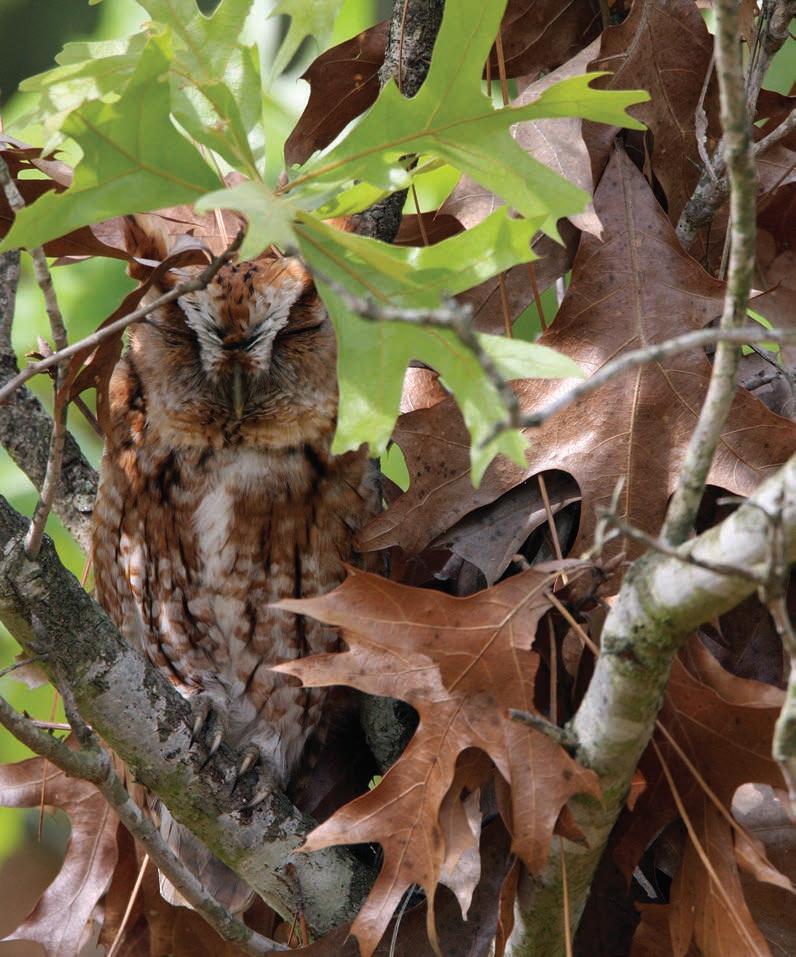

With its large, false eyes a spicebush swallowtail caterpillar mimics a snake.
Story and Photogra PhS by todd P uSSer
Spending the better part of the morning cleaning up limbs and pinecones left over from the previous night’s storm, I slowly make my way around our suburban yard. Ominous clouds finally give way to bright blue sky and a blazing August sun. Near the brick steps leading up to the front door, I pause. At the top of a waist-high spicebush, a single curled leaf, nestled among a bouquet of more “normal-looking” straight leaves, catches my eye. My pulse quickens.
Over the past few years, I have made a concerted effort to replace the ornamental shrubs and non-native flowers that line our walkway with more wildlife-friendly native plants. It’s been a slow
process, but the obvious increase in pollinators in the yard, in the form of bees, moths and butterflies, has shown that the work is starting to pay dividends.
A small shrub native to eastern North America, spicebush produces abundant red berries throughout summer and fall that the local birds love. Named for its aromatic leaves, which smell like citrus and allspice, spicebush also attracts the attention of one very special butterfly, the aptly named spicebush swallowtail. These black, palm-sized butterflies lay their eggs on the shrub’s fragrant leaves. Upon hatching, the caterpillar larvae munch the spicebush leaves (their primary food resource) with gusto, much in the same way I tear into a bag of barbecue potato chips.



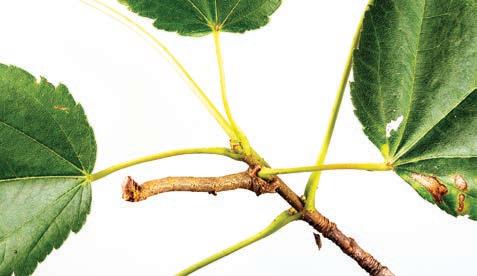
Clockwise from top left: oak treehoppers resemble growth buds on the limb of an oak tree. Curled tightly on a leaf, a viceroy caterpillar looks like a piece of bird poop. A twigmimic caterpillar lives up to its name. With rapid wingbeats, a hummingbird clearwing moth hovers in front of a flower just like a hummingbird.
I have monitored the spicebush every day since I planted it two years ago. Noticing the curled leaf, a telltale sign of an enclosed caterpillar, it looks like I have finally lured in a customer.
Like a kid on Christmas morning, eager with anticipation, I bend over and slowly unfurl the edges of the leaf, revealing a half-inch-long caterpillar. Immediately, two large yellow eyespots on its head grab my attention. Despite knowing what to expect, it is still a bit startling. Imagine how a hungry bird, like a cardinal, might respond.
You see, this special caterpillar is a snake mimic, and a darn
good one at that. Its false eyes come complete with large black pupils. There is even a tiny white spot, a “catchlight” in each, which only adds to the illusion. Throughout the day, the caterpillar remains in its shelter, with the edges of the leaf pulled around its body, always with its head pointed up toward the tip of the leaf. That way, if a foraging bird were to encounter it, the first thing it would see would be the “face” of the snake.
For most of my life, I have been battling the misconception that one has to travel to far off tropical islands and jungles to find wild wonders. As a child, fed on a steady diet of television
The scarlet kingsnake is a near perfect match of the venomous coral snake.

shows like The Undersea World of Jacques Cousteau and Mutual of Omaha’s Wild Kingdom, I could not wait to escape the confines of little ol’ Eagle Springs and explore the world. Now in my 50s and burdened by the usual hurriedness and complexities of adult life, I have to constantly remind myself that there are marvels to be found close to home. Discovering something like a caterpillar that mimics a snake right outside the front door never fails to illicit that childlike wonder of a world filled with infinite possibilities.
The drama between life and death plays out every second of every day across every nook and cranny of the wild. It’s an eat-or-be-eaten world out there. To gain a level of advantage, countless organisms utilize deception in their never-ending bid to stay alive. Camouflage and mimicry are the templates for survival. Optical illusions abound.
Take caterpillars, for instance. As they grow, all species shed their skins many times before pupating into a butterfly or moth. Biologists refer to each of these skin-shedding molts as instars. Caterpillars are packed with protein and many animals love to eat them, especially birds. One study found that a single clutch of young chickadees can consume up to 6,000 caterpillars before they fledge.
To avoid becoming a meal, caterpillars resort to all manner of trickery throughout different stages of their life cycles. Many resemble tree bark; others, twigs. Some look like lichen. A few
possess vicious-looking armaments to deter would-be predators. A hickory horned devil, the largest caterpillar in North America, sports a pair of huge horns on its head. When disturbed, the devil thrashes its head violently from side to side, slamming its horns into its aggressor. Though intimidating, the hot dog-sized caterpillar is completely harmless. The snake-mimicking spicebush swallowtail caterpillar, mentioned earlier, is an even more surprising trickster in an early instar form, when its mottled black and white coloration resembles an unappetizing splatter of bird poop.
All caterpillars eventually metamorphose into butterflies and moths. And like their pupa, these winged wonders are relentlessly pursued by predators. As such, many of our native butterflies and moths rely on camouflage and mimicry to avoid becoming an easy meal.
Last summer, while walking along the edge of my parents’ Eagle Spring’s yard, I paused to look at a wasp perched atop a grapevine leaf. Underappreciated and loathed animals, such as wasps, hold a special place in my heart, and I cautiously stepped closer to examine the brightly colored insect in more detail. I realized something was a little off. For one thing, it had clear wings. Most wasp wings are opaque or dark. It also had a pair of bushy antennae and a wide waist — very unwasplike. Finally, I noticed that hairy tufts extended out from the tip of its abdomen instead of a stinger. It suddenly dawned on me. I was not looking at a paper wasp at all, but rather a day-flying moth known as a graperoot borer. Its disguise was on point.
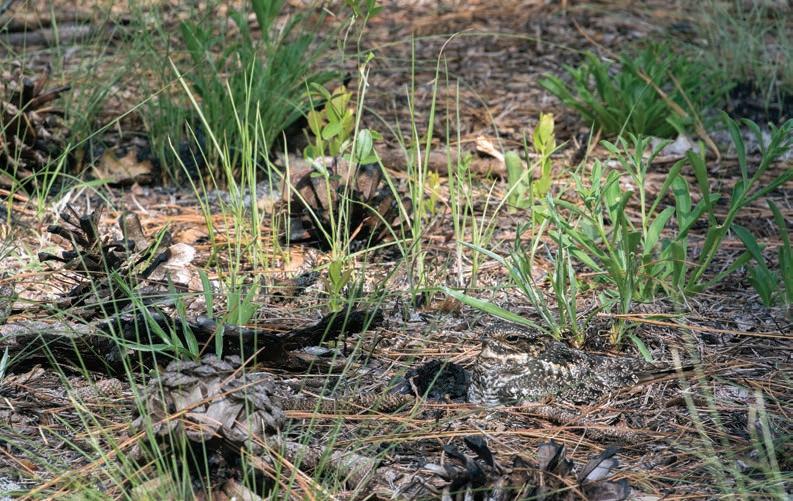
Many insects, especially flies, beetles and moths, mimic stinging bees and wasps. Defenseless organisms that mimic dangerous ones employ an evolutionary survival strategy that biologists refer to as Batesian mimicry. Named for the Victorian naturalist Henry Walter Bates, who first described the phenomena in the humid jungles of the Amazon, this form of mimicry is surprisingly common and is not limited to insects.
Here in the Sandhills of North Carolina, the secretive and beautiful scarlet kingsnake is a dead ringer (pun fully intended) for the venomous coral snake. Both snakes possess alternating colorful bands of red, yellow/white and black and can be hard to tell apart. I still recall a little rhyme taught by Larry Dull, my sixthgrade science teacher at West End Elementary, to help distinguish between the two. “If red touches black, that’s a friend of Jack’s. If red touches yellow, it will kill a fellow.”
Several years back, while walking along the edge of Drowning Creek on my great-grandfather’s farm, I almost had a heart attack. While I was casually stepping over a fallen tree on a spring afternoon, a wild turkey suddenly flew out from underneath my feet. The sound and commotion of a 12-pound bird, with a 5-foot wingspan, launching into the air right in front my face, was startling to say the least. It got my attention. My cholesterol levels instantly bottomed out. Thoroughly shaken, I had to sit down on
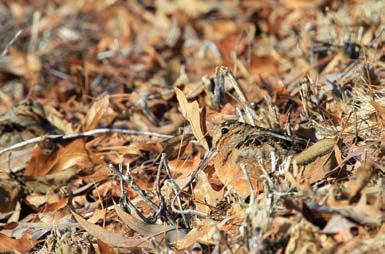
the log for several minutes and compose myself.
Turns out, I had flushed a hen off her nest. On the ground, next to the fallen tree, were a dozen large white eggs nestled in the leaf litter. How I failed to see such a large bird, sitting there at close range, still baffles me. Her muted brown, grey and black feathers blended in seamlessly with the highlights and shadows of the forest floor on that bright sunny day.
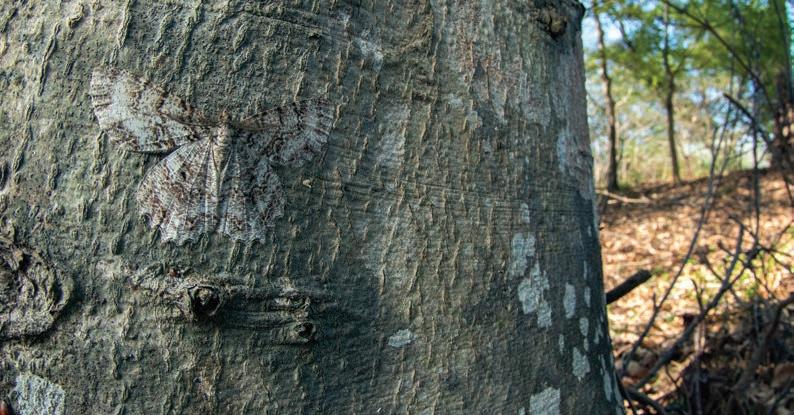
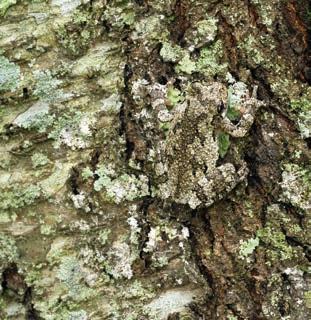
In 1890, a British zoologist named Sir Edward Poulton wrote the first book about camouflage in nature. Poulton, an ardent supporter of Charles Darwin, wrote that camouflage and mimicry in the wild was proof of natural selection. Not long after, an American painter, Abbott Thayer, expanded on Poulton’s ideas and began creating photographs and pieces of camouflage art using countershading and disruptive coloration, culminating in his own 1909 book, Concealing Coloration in the Animal Kingdom. Thayer’s illustrations, showing how objects could “disappear” into the background when they were painted in such a way as to cancel out their shadow, became quite popular and soon attracted the attention of the military. By World War I, armies around the globe were incorporating camouflage into equipment and the uniforms of their soldiers. Long gone were the days of Paul Revere and the brightly attired Redcoats.
Camouflage has even become fashionable. Most popular clothing brands offer an array of camo products, everything from hats to wedding dresses, and shoes to underwear (though I am not entirely sure as to what purpose the latter serves). Even luxury lines like Louis Vuitton have jumped in.
Of course, all of this fashion is modeled after animals in the wild and few wear camouflage as well as the nightjars. These ground-nesting birds, of which there are roughly 98 species recognized worldwide, are the masters of cryptic coloration. In the North Carolina Sandhills, three species are found: the common nighthawk, the chuck-will’s widow, and the whip-poor-will. Each year, I celebrate the first nocturnal calls I hear of the whip-poor-will (usually heard around Eagle Springs in late March) as the harbingers of spring and warmer days ahead.
Nightjars are extremely difficult to find due to their cryptic camouflage. As a result, I have very few photographs of them in the wild. Recently, I received a tip from a local biologist about a nesting common nighthawk on the Sandhills Gamelands. He gave me a GPS point and noted that the bird could be found between two small turkey oaks flagged with bright pink tape.
With that information in hand, I ventured out onto the dirt roads of the
Gamelands in early June with hopes of obtaining a few images of the secretive bird. Being extremely careful not to disturb the nesting nighthawk, I slowly approached the GPS point and stood back at a distance of over 10 yards when I saw the bright pink flags up ahead. Raising binoculars to my eyes, I slowly scanned the ground between the two turkey oaks trying to locate the bird. Remember those “Magic Eye” paintings that were so popular in the ’90s? It took several minutes of intently staring at the leaves on the ground before I had the “aha” moment of finally seeing the bird.
The thrill of discovering animals hidden in plain sight never gets old. I still recall with great fondness hiking through the woods one spring day and stumbling upon a young white-tailed deer fawn, curled up tightly on the forest floor beneath a canopy of cinnamon ferns, the white spots on its back allowing the hapless mammal to blend in seamlessly with its background.
Then there was the time I saw an American bittern fly up from the side of the road in the Outer Banks and land in a nearby patch of marsh, where it stood perfectly still with its head pointed to the sky. Its mottled brown plumage perfectly matched the surrounding spartina grass.
One winter, years ago, a Pinehurst resident pointed me to a tree where an Eastern screech owl could be seen basking daily in an open cavity about 20 feet off the ground. Even
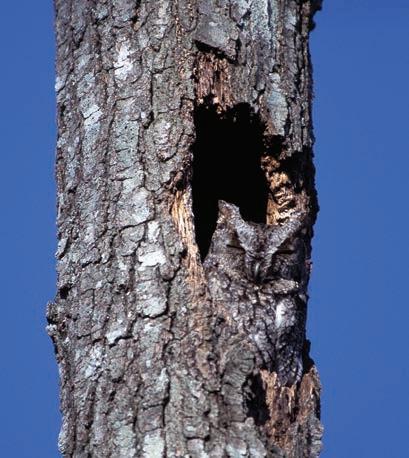


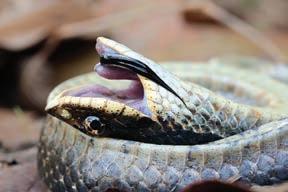
now, looking at the photos of that owl, it is hard to tell the difference between the owl’s grey feathers and the bark of the tree.
When camouflage fails, some animals will resort to the ultimate form of trickery, mimicking death. The term “playing possum” comes from the behavior of the Virginia opossum, North America’s only native marsupial, which feigns death when threatened by predators. As it turns out, a number of our native animals will resort to that tactic as a last resort. Perhaps the most famous “death actor” is the eastern hognose snake. When confronted by a threat, this robust, 3-foot long serpent, with a distinctive upturned snout, puts on a performance that would make members of Hollywood’s Screen Actors Guild envious.
One of my most memorable encounters with an eastern hognose snake happened years ago near West End. One summer afternoon, a family friend phoned to tell me that she had just found a copperhead in the yard. She asked if I could come over, catch the snake and move it to safe spot (i.e., somewhere far away from her). Surprised, and impressed that she did not want to kill the snake, I hurried over. As I said before, I am a sucker for loathed animals.
When I arrived, I saw my friend standing in her front yard pointing to a small snake coiled tightly several feet away. A neighbor, whom she had called in a panic before dialing me, was standing
close by with a shovel in hand. Walking over, I instantly realized it was not a venomous copperhead but a harmless eastern hognose snake. My friend nearly fainted when I casually reached down to pick it up. Her face completely drained of color when the snake began to violently thrash about in my hands. It was only then that I informed her the snake was completely harmless and placed it back down on the ground. There, it continued to writhe back and forth, as if in pain, rapidly throwing coils up over its head. Then it proceeded to defecate all over itself. Finally, the snake lay perfectly still, belly up and mouth agape, its tongue sticking out.
Of course, it wasn’t physically harmed in any way. It simply wanted to make itself appear unappetizing. An especially nice touch, I thought, was covering itself with its own poop.
How these death-feigning tactics evolved over eons of time simply boggles the mind. It certainly threw my friend for a loop. I reached down and slowly turned the snake right-side up. Immediately, it flipped back over onto its back, presenting itself once again as the quintessential dead snake. I smiled. Charles Darwin would have been proud. PS
Naturalist and photographer Todd Pusser grew up in Eagle Springs. He works to document the extraordinary diversity of life both near and far. His images can be found at www.ToddPusser.com.
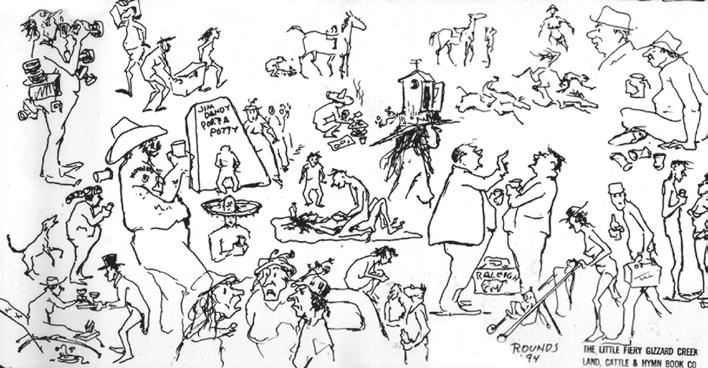
A springtime tradition like no other




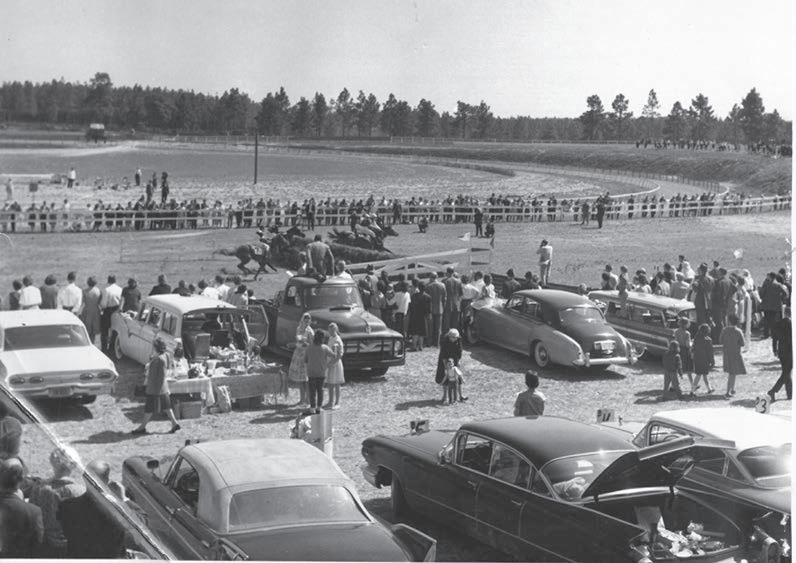
Elevated to one-word status, the locals simply called it Stoneybrook. But it was much bigger than just a day at the races.
The Stoneybrook Steeplechase was an outdoor cocktail party rivaling the grandest in the Southeast, and once you went, you never wanted to miss it again. Whether folks donned fancy hats and dined at banquet tables adorned with fine linens and chilled Champagne, sat on the back of a pickup truck with a bucket of Kentucky Fried Chicken and a cooler of beer, or spread a blanket on the grass with a picnic basket, it was the place to be. More than just a lively celebration, though, Stoneybrook embodied the thrill of horse racing.
The perfect parking spot was as coveted as a family heirloom. People arrived on foot or by bus, in cars or by limo, but regardless of how they got there or where they came from, when they heard the announcer say “The flag is up!” they raced to the rails to watch. At its peak, nearly 40,000 spectators packed into Mickey Walsh’s Stoneybrook Farm, transforming it into a carnival of
energy and tradition. It was the first sunburn of spring, and the ultimate mingling of community and family.
On St. Patrick’s Day 1947 Michael G. “Mickey” Walsh, an Irishman from Kildorrery, County Cork, Ireland, brought his dream of starting a steeplechase race to life on his 150-acre farm in Southern Pines. That year, the first Stoneybrook Steeplechase set the stage for nearly half a century of camaraderie, equestrian excellence and cherished memories — not just for the thousands who attended, but especially for Mickey’s own family.
After immigrating to the United States in 1925, Walsh gained fame in the show jumping world, where his horse, Little Squire, achieved a remarkable three consecutive wins at Madison Square Garden. With ambitions that stretched beyond show horses Walsh settled in Southern Pines in 1944 with his wife, Kitty, and transitioned to steeplechase racing, where he became the nation’s leading trainer from 1950 to 1955. The Stoneybrook Steeplechase would become part of the National Steeplechase and Hunt Association in 1953 and one of the premier horse races in the Southeast.
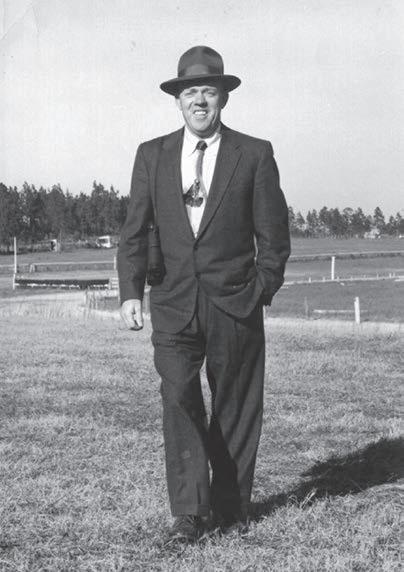
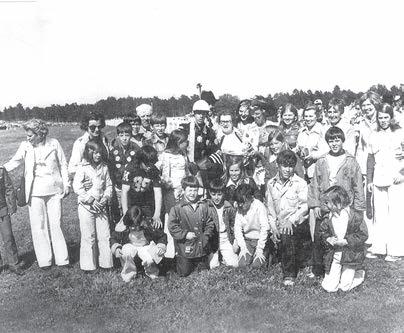
The success of Stoneybrook relied heavily on the community. The Knights of Columbus organized the parking logistics and directed the influx of visitors on race day, and in the spirit of community that defined Stoneybrook, profits from the event were donated to St. Joseph of the Pines, a nursing home. Within the Walsh family, the event was a labor of love. Marion Walsh, Mickey’s daughter-in-law, managed the Stoneybrook office for many years before the responsibility fell to Phoebe Walsh Robertson, Mickey’s youngest daughter. From selling parking spots to securing sponsorships or working with the horses, all the Walsh women played a vital role in sustaining the tradition.
For the Walshes, Stoneybrook was far more than a public event — it was a cornerstone of their lives. The farm was a haven for Mickey’s children and grandchildren, who spent their days riding horses, playing in hay barns and absorbing the rhythms of farm life. Duties like mucking stalls and riding racehorses before school cultivated a deep appreciation for hard work and horsemanship.
Mickey’s daughters Cathleen, Joanie, Audrey and Maureen were accomplished riders, and raced a time or two. Later, his grandson, Michael G. Walsh III, followed in their footsteps, becoming a leading amateur jockey. In one poignant moment Mickey watched his grandson race at Stoneybrook, riding every jump in spirit alongside him. When young Michael crossed the finish line in first place, Mickey’s pride was unmistakable, his joy radiating through his smiling Irish eyes. His siblings and cousins shared in the pride, racing to the winner’s circle to surround him for the winning photo.
Stoneybrook weekend was a cherished reunion for the entire family. With seven children and 29 grandchildren, the gathering brought relatives from across the country, including Oklahoma, Boston and New York. Close friends, like the Entenmann family — famous for their baked goods — also attended every year, adding sweetness to the occasion.
The festivities extended beyond race day, beginning with the Stoneybrook Ball on Friday night. On race morning, Grandmom Kitty hosted her renowned Owners, Trainers and Riders Brunch, preparing all the dishes herself. Following the races, the celebration continued with an evening reception for horse owners, trainers and jockeys, featuring music, food and drinks. Sunday brought the weekend to a close with a lively bocce ball tournament hosted by Mickey’s son, Michael G. Walsh Jr.
As each Walsh family member reached adulthood, they embraced the full spectrum of Stoneybrook’s traditions, bringing their friends to share in the magic. The event became a rite of passage, a chance to create lifelong memories and forge lasting connections. Even as the races drew thousands, the essence of Stoneybrook remained intimate for the Walsh family. It was a tapestry of laughter, camaraderie and shared experiences. This sense of togetherness extended to the broader community, where old friendships were rekindled and new ones blossomed.
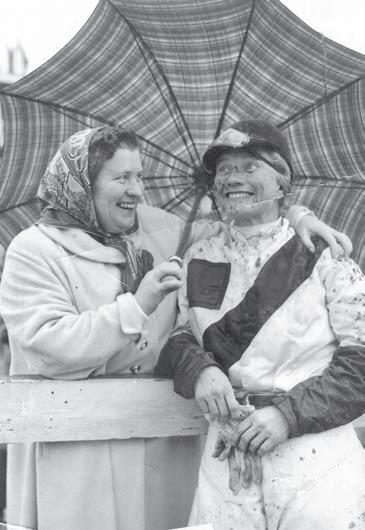
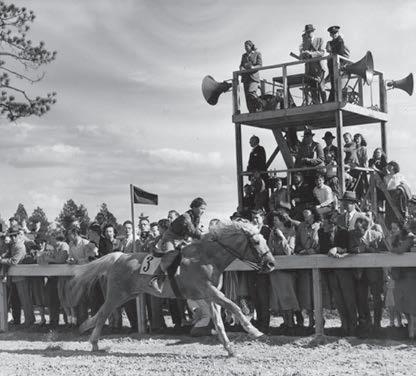
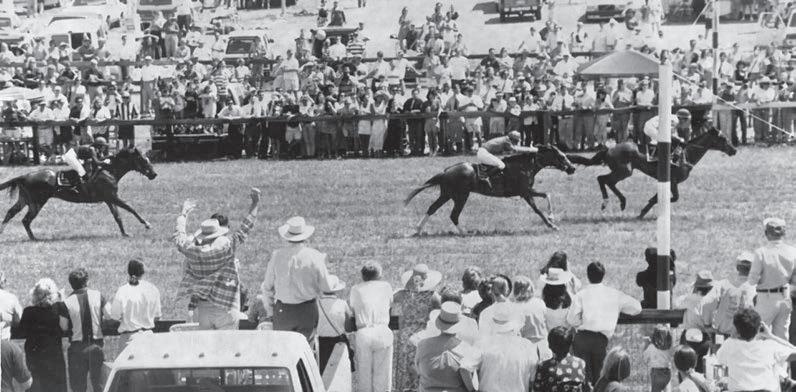
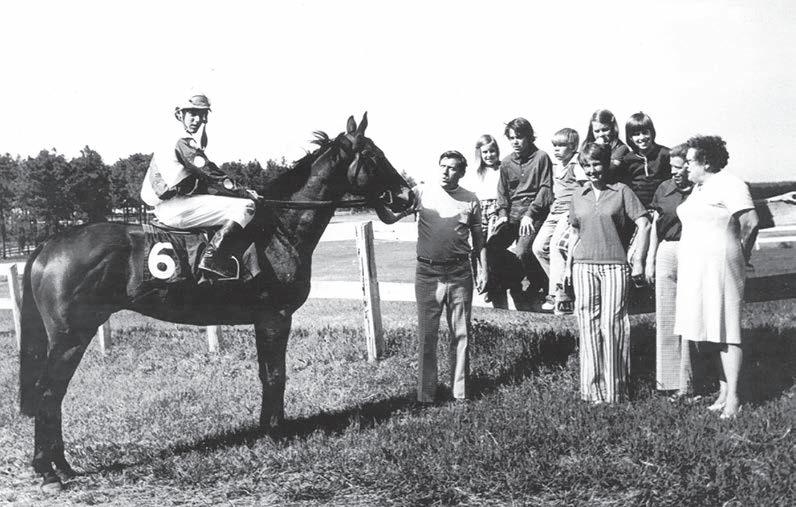
Mickey Walsh’s passing, in 1993, marked the end of an era. The races at Stoneybrook Farm eventually ceased in 1996, but their impact lingered in the hearts of all who had been part of them, spectator and family alike.
For the Walshes, the memories of those weekends — the excitement of the races, the joy of reunion, the shared pride in their heritage — remained indelible. Though the races ended just shy of 30 years ago, the memories endure, a lasting tribute to Mickey Walsh and the indomitable spirit he embodied. PS
Chrissie Walsh Doubleday and Tara Walsh York are granddaughters of the late Mickey Walsh Sr. of Stoneybrook Farm. Chrissie is a retired teacher who enjoys competing locally with her Irish Sport horse, Woodford, and retired racehorse, George. Tara is the North American technical director for a UK-based feed enzyme company. They live side by side on the property where they were raised, preserving their connection to Stoneybrook Farm.
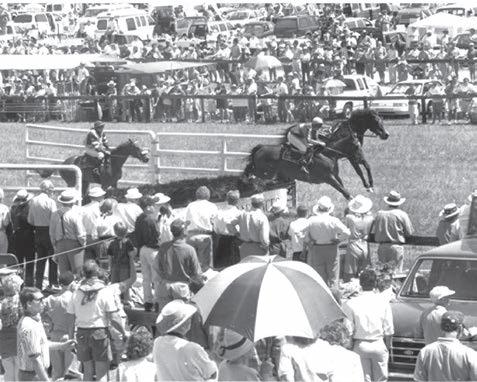

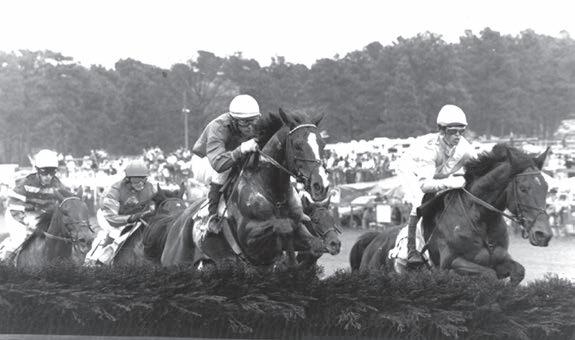

by bill Ca Se • Photogra PhS from the tuft S a rChiveS
He had survived — a luckier fate than that suffered by millions of World War I soldiers — but his battlefield injuries were grievous. A German mustard gas explosion had totally blinded the young Edinburgh native. One lung was badly burned by the gas. In another engagement, shrapnel from an enemy shell caused serious injuries to his head and left arm, necessitating the implanting of metal plates. Lying battered and helpless in a British military hospital bed, the odds seemed heavily against Tommy Armour ever resuming a normal life.
Serving in the Black Watch Regiment’s tank corps from 1914 to 1918, Armour rose from the rank of private to staff major and achieved widespread notoriety for his machine-gunning prowess. He assembled, loaded and fired his weapon faster than anyone in the Army. This singular talent required superior manual dexterity but, in addition, his hands were remarkably strong: While singlehandedly capturing a German tank, Armour strangled the tank’s commander to death when he refused to surrender.
Prior to the war, those formidable hands had served him well. Among his talents, Armour was a virtuoso violinist and a highlevel bridge player, but his favorite pastime was golf. Armour, his older brother Sandy, and lifelong friend Bobby Cruickshank toured Edinburgh’s Braid Hills Golf Course at every opportunity. “In the summer,” Armour later recalled, “I would be on the first tee at 5 a.m. and in the evening . . . play a couple of rounds.”
Throughout his convalescence, Armour kept up his spirits by dreaming of playing golf again. While it took six months, sight gradually returned to his right eye, though he remained blind in his left. The recuperating 23-year-old would play golf again, but could his limited vision scuttle any hope of regaining his previous form? The preternaturally confident Tommy Armour believed otherwise.
Armour joined Edinburgh’s Lothianburn Golf Club with the expectation of not just recovering his game but elevating it. Adapting to his partial blindness, he steadily lowered his scores, though his putting was erratic. The blindness in his left eye was distorting his depth perception. One day, in a fit of pique, he hurled his collection of putters off the Forth Rail Bridge into the firth below. It was these all-too frequent episodes of balky putting that would one day prompt him to coin the phrase “the yips.”
Despite his weakness on the greens, Armour began making his presence felt in tournaments, finishing runner-up in the
1919 Irish Amateur at Royal Portrush. He really raised eyebrows when he won the French Amateur in July 1920. Soon afterward, Armour sailed to New York, looking to test his game against America’s best. While aboard ship he met Walter Hagen, the game’s top professional golfer. The two men found they had much in common: Both enjoyed parties, the company of attractive women, and the consumption of copious amounts of alcohol. As author Mark Frost wrote in The Grand Slam: Bobby Jones, America, and the Story of Golf, the young Scot had a capacity for liquor surpassing his older friend. “Whereas ‘The Haig’ often watered down drinks to polish his reputation as a boozer,” wrote Frost, “Armour’s glass was never half-empty.”
Hagen took the young man under his wing, setting up an exhibition match for the visiting amateur’s American debut. On July 25 the fellow bon vivants squared off against Jim Barnes and Alex Smith in New London, Connecticut. The Armour-Hagen team lost the match 1-down, but The New York Times reported that Armour’s “long driving surprised the gallery,” and that his mashie play “stamped him as a golfer who will be hard to beat.”
In early August 1920, Armour entered the U.S. Open at Inverness Country Club, in Toledo, Ohio, finishing 48th, 22 strokes behind winner Ted Ray. But those who assumed the hype regarding this Scottish upstart had been overblown were in for a surprise two weeks later at the Canadian Open. Playing brilliantly throughout, Armour finished the championship in a three-way tie at the top with Charles Murray and J. Douglas Edgar, eventually losing the playoff to Edgar. The Scot followed that promising finish with another, reaching the quarterfinals of the U.S. Amateur at Engineers Country Club in Roslyn, New York.
While stateside, Armour found time for other pursuits. An October 29, 1920, New York Times article reported that the golfer had wed 26-year-old Consuelo Carreras de Arocena the previous day. A son, Thomas Dickson Armour Jr., would be born to the couple a year later.
Though Armour had played creditably that summer, he had yet to achieve a victory on U.S. soil. That changed in November after he arrived in Pinehurst to compete in the resort’s inaugural Fall Amateur-Professional Best Ball Tournament on course No. 2. The event attracted many leading players, including Gene Sarazen, the aforementioned Douglas Edgar, and Leo Diegel, later a two-time PGA champion.
Already recognized as a tournament hotbed, the Pinehurst
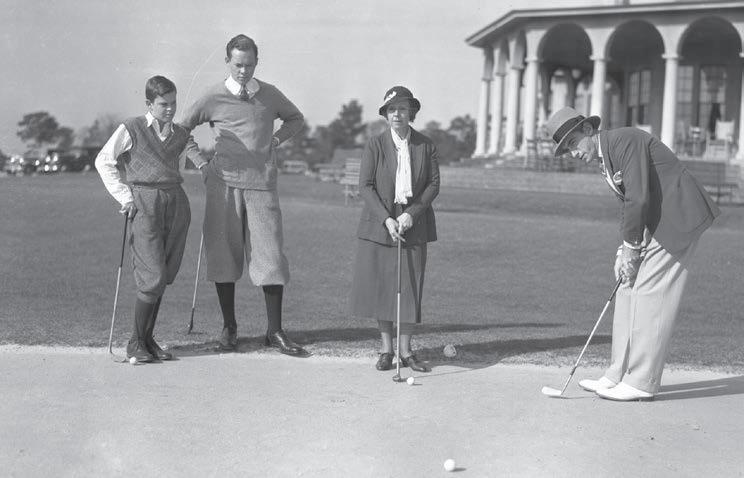
resort successfully lured top players for tournaments on their way south for the winter and then again on their way northward in the spring. March and April were the months when the United North and South Amateur championship and the North and South Open were held. The tournaments attracted resort visitors looking to spot their favorites both on and off the course. What could be more appealing to a devout golf fan than encountering the legendary Walter Hagen in The Carolina Hotel bar?
Pinehurst appealed to Armour as well. Partnering with Diegel, the two ham-and-egged their way to the Amateur-Professional title, posting a four-round best ball score of 275. The win provided the Scot a measure of revenge against Edgar, whose team finished runner-up. The euphoric Armour extended his stay, competing in the resort’s match play Fall Tournament. He reached the quarterfinals before bowing to Frances Ouimet. After that, Armour and his bride sailed home to Great Britain.
Back in Scotland, Armour continued to polish his game in amateur tournaments. In May 1921, he joined a team of British amateur stars for a match against a formidable American team that included Bobby Jones, Chick Evans and Ouimet. The informal match, held at Royal Liverpool Golf Club and won by the U.S., drew over 10,000 spectators and sparked the institution of the Walker Cup matches the following year.
Having experienced the good life in America, Armour yearned to return. Following the 1921 slate of British golf championships,
he was back in the U.S. competing in tournaments. In October he informed the press he intended to make America his permanent home. Armour’s brother Sandy and Braid Hills running mate Cruickshank also chose to emigrate. The New York Times observed, “The British golf world is faced with the odd spectacle of its previous defenders against American invasions being members of future attacking parties.”
Still an amateur, Armour looked to establish himself in America and, once again, Hagen came to the young man’s aid, making the connections that led to Armour being hired as the secretary of Westchester-Biltmore Country Club in Rye, New York. A sprawling complex, the club featured two golf courses, a polo field, racetrack and 20 tennis courts, built at a cost of $5 million.
Armour’s natural social skills made him ideal for the post. He deftly saw to the needs of the Biltmore’s guests and entertained them as well, regaling patrons with raucous stories evoking paroxysms of laughter. Byron Nelson considered Armour the most gifted storyteller he ever knew. “He could take the worst story you ever heard,” said Nelson, “and make it great.”
Armour’s job kept him busy during the warmer months, but when the weather turned chilly, he headed to Belleair, Florida, where he played numerous matches and tournaments against top players. Convinced he could hang with golf’s upper echelon, he turned professional in 1924. Soon after, Armour became the professional at Whitfield Estates Country Club, a Donald
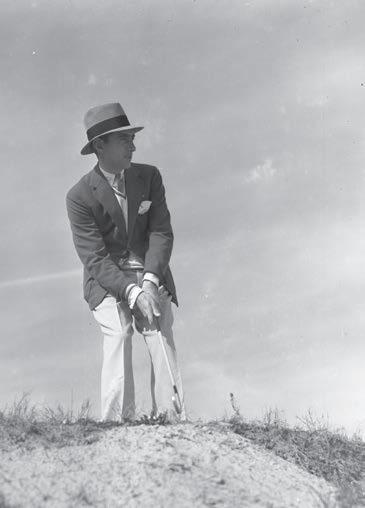
Ross-designed golf course (now Sara Bay Country Club) that was part of a Sarasota real estate project. Lifetime amateur Bobby Jones was also on-site, earning some extra dough peddling lots as the project’s assistant sales manager. Armour played golf daily, frequently in the company of either Jones or Hagen, who was affiliated with a nearby golf community.
In March 1925, Armour won the Florida West Coast Open, his first victory as a pro. With the North and South Open approaching, the triumph did not go unnoticed in the Sandhills. A piece in the Pinehurst Outlook reported that the word coming out of Florida was to “watch Tommy Armour!” The transplanted Scot played admirably in the North and South, finishing fourth.
Though Armour was rapidly progressing up the pecking order of top players, his share of tournament purses was never going to be enough to make a decent living. Even the game’s greatest supplemented their incomes by competing in exhibitions and securing club pro affiliations for both the summer and winter. Armour landed a premier summer gig as pro at Congressional Country Club in Bethesda, Maryland. Over the years, he would prove something of a vagabond in his northerly club employments: Medinah in Chicago, Tam-O-Shanter in Detroit, and Rockledge in Hartford would be featured among his other stints. Armour’s primary goal, however, was to win tournaments. After two years adjusting to tour play, he skyrocketed to superstar status, winning five titles in 1927, including the U.S. Open held
at America’s most demanding course, Oakmont Country Club. Trailing Harry Cooper by a shot as he arrived at the green of the championship’s final hole, Armour faced a birdie putt from 10 feet to force a playoff.
Bobby Jones, who was in the gallery, overheard two spectators debating whether any golfer would be able to successfully handle the pressure of such a critical moment. Jones calmly informed the bystanders that a man who had snapped the neck of a German tank commander with his bare hands was unlikely to be bothered by a 10-foot putt, regardless of its import.
Armour cooly drained it. In his 18-hole playoff victory over Cooper, Armour took just 22 putts over Oakmont’s diabolical greens. Perhaps he wasn’t such an awful putter after all.
The victory, coupled with his charismatic persona, thrust Armour into golf’s spotlight. Tall, dark, handsome and, like Hagen, impeccably attired, Armour, was a hit with the ladies, an attraction he did nothing to discourage. A penchant for heavy gambling, particularly on the course, also drew attention. Golf great Henry Cotton expressed uncertainty as to what Armour liked best, the golf or the betting. “He is not satisfied,” claimed Cotton, “unless he is wagering on every hole, every nine, each round, and if he can, on each shot.”
Augmenting Armour’s swagger was the occasional wearing of a patch over his left eye. He sported the best nickname on tour — The Black Scot — referring to the jet-black hue of his luxurious head of hair.
More victories followed. By the time Armour arrived at Fresh Meadows Country Club in Flushing, New York, for the 1930 PGA Championship, he had eight more tournament titles to his credit, including the prestigious Western Open. In his quarterfinal match at Fresh Meadows against Johnny Farrell, Armour found himself 5-down after six holes before rallying to win. Fighting his way to the championship’s final match, he took on Gene Sarazen in a nailbiter, beating “The Squire” on the 36th hole.
By 1930 Armour’s domestic life was in turmoil. In the course of his wanderings, he had met Estelle Andrews, the widow of an iron manufacturer. They started an affair, a fact unappreciated by Armour’s wife, Consuelo, who responded by initiating a series of lawsuits. Eventually, the differences were resolved; Armour got divorced, married Estelle, and adopted her two teenage sons, Ben and John. “Love and putting are mysteries for the philosopher to solve. Both are subjects beyond golfers,” said Armour.
In 1931, he won what, given his Scottish background, was his most meaningful title, the Open Championship at Carnoustie. An early finisher in his final round and sitting in a distant third place, Armour anxiously sipped whisky in the clubhouse while awaiting the two men ahead of him — Jose Jurado and Macdonald Smith — to complete their rounds. “I’ve never lived through such an hour before,” he told reporters. Jurado and Smith both collapsed, and Armour won the championship by one stroke, giving him a victory in all three of the major championships then available.
The rigors of travel and competition were beginning to take a toll on Armour, hastening the graying of his hair which, in turn, necessitated a nickname modification. Henceforth he was the Silver Scot.
Armour began slowing things down a bit by lengthening his sojourns in Pinehurst. His affection for the town would blossom into a full-blown love affair. His first extended visit occurred in the fall of 1932. After winning the resort’s Mid-South Best Ball Tournament with partner Al Watrous, the Armours, Tommy and Estelle, stayed over at The Carolina for several weeks’ rest before decamping to Boca Raton Hotel and Club, a winter head professional gig Armour would keep for the remainder of his life.
While in Pinehurst, the couple relaxed and socialized like any other guests of the resort. They brought sons Ben and John, both cadets at New York Military Academy, to Pinehurst for the holidays. The couple’s frequent movie attendance at the Pinehurst Theatre was dutifully reported in the Outlook. The Armours attended a dinner hosted by Southern Pines Country Club professional Emmett French, himself a three-time tour winner and runner-up in the 1922 PGA Championship. The Armours reciprocated, inviting the Frenches to dinner at The Carolina.
And, like most visitors to Pinehurst, Armour played loads of golf, generally with excellent players like French, Halbert Blue and poet Donald Parson, all reported in the Outlook. As the Armours prepared to depart Pinehurst in mid-January 1933, the paper recapped Tommy’s sensational scoring: “For a stretch of two weeks there was not one day in which Armour failed to equal or better the par of 71 for the No. 2 course. He had as low as 65 one day, this figure failing by one stroke to equal a round of his last month which tied the course mark.” And Armour revered No. 2, saying, “it is the kind of course that gets in the blood of an old trooper.”
In the spring of 1933, the Armours arrived early for the North and South and stayed two weeks after. Ben and John visited again, and Tommy played rounds with Pinehurst’s young phenom, George Dunlap Jr. Later that year, Dunlop won the U.S. Amateur, attributing significant credit for his victory to Armour. “Watching him play, of course, was a lesson in itself,” said Dunlop.
In December 1933, the Armour family once again celebrated the Christmas holidays in Pinehurst, and Armour was elected an associate member (later designated as an honorary member) of Pinehurst’s venerable golf society, the Tin Whistles. Returning in the fall of ’34, he paired with his boyhood friend Cruickshank to win the Mid-South Scotch Foursomes. After the victory Tommy and Estelle remained in Pinehurst, enjoying an array of social functions and attending the theatre, until the second week of January.
After 1935, Armour was competing only sparingly on tour. He was hired by MacGregor Golf in 1936 and, unwilling to simply sit back and endorse the company’s clubs, actively involved himself in their design. As a result, MacGregor became the industry-leading club manufacturer. “Tommy Armour” brand clubs are still made and marketed today.
Armour achieved fame as an instructor, despite delivering frequent tongue lashings to his pupils. An article by H.K. Wayne described his unique teaching methods: “His preferred style involved sitting in the shade in Boca Raton each winter or in Winged Foot each summer, with his trademark tray of gin, Bromo-Seltzers and shots of Scotch and passing judgment on his wealthy pupils, all of whom feared him.” Armour would subsequently author, with the assistance of golf writer Al Barkow, How
to Play Your Best Golf All the Time, a bestseller, still in print.
Armour continued making pilgrimages to Pinehurst. The more time he spent in the Sandhills, the more he rhapsodized about how wonderful it was to be there. His fawning quotes were undoubtedly appreciated by the resort’s public relations department. “I’ve seen strangers, jaded and dull, come to Pinehurst, and after a few days be changed into entirely delightful fellows,” said Armour. Pinehurst’s practice ground elicited quotable praise. “Maniac Hill is to golf,” he asserted, “what Kitty Hawk is to flying.”
In yet another homage, he declared, “I can’t help it. Pinehurst gets me. From morning firing practice at Maniac Hill, to vespers at the movies, Pinehurst is the way I’d have things if it were left to me to remold this sorry scheme of things entirely. . . . It’s the last in the vanishing act of fine living.”
In a sense, Armour promotes Pinehurst even today. Exhibited in the resort clubhouse’s hallway of golf history is a rotating display that provides another Pinehurst tribute from the Silver Scot. It neatly combines in one statement his sentimentality and occasional brusqueness, reading, “The man who doesn’t feel continually stirred when he golfs at Pinehurst beneath those clear blue skies and with the pine fragrance in his nostrils is one who should be ruled out of golf for life.”
When Armour came to Pinehurst in November 1938 to play the resort’s two professional events — the Mid-South Professional Best Ball and the Mid-South Open — he was semi-retired from competition. His last individual tournament victory had taken place three years prior at the Miami Open. Inspired by his surroundings, the 42-year-old rekindled his old form. Not only did he and sidekick Cruickshank tie for the best score in the best ball, Armour won the individual title, too. It would be his 25th and last PGA Tour victory.
One of the few titles to elude Armour’s grasp was the North and South. This gnawed at him both because of his love of the venue and because of the tournament’s prestige. Runner-up twice, Armour dwelled on his near misses, ruminating that “there are five traps on this course (No. 2) that have cost me the North and South five times.” He continued competing in it long past his competitive heyday. He even had a shot at victory after the tournament’s first two rounds in 1948 when his 143 total left him just three strokes out of the lead, but an 81 in round three ruined the aging veteran’s bid.
In 1951, Armour attended Pinehurst’s lone Ryder Cup. It turned into a delightful reunion for the 54-year-old. Longtime friends Hagen, Sarazen and Cruickshank were also on hand, and Armour delightedly joked and hobnobbed with the old stalwarts. When Hagen held a driver for a photo op with his fellow legends, Armour, ever the scolding instructor, pointed out, “You never gripped a club that way in your life!”
The North and South immediately followed the Ryder Cup, and Armour gave it one final try, missing the cut by two shots. The ’51 event also marked the end of the line for the North and South itself — the result of a brouhaha between the PGA tour and Pinehurst resort owner Richard Tufts. He had resisted efforts by the tour to have the amount of prize money bumped from $7,500 to $10,000 — the tour minimum. In response,

several American Ryder Cuppers left Pinehurst following the matches, effectively boycotting Tufts’ event. Only one team member, Henry Ransom, completed all 72 holes. Reciprocating the hard feelings, the miffed Tufts terminated the North and South after a 50-year run.
In Armour’s later years, he kept on playing, teaching, storytelling, gin playing, gambling and cocktailing. In a 1978 Sports Illustrated article, Scottish writer and an excellent golfer in his own right John Gonella recounted an experience 30 years before when Armour hosted him at the Boca Raton Hotel. The writer was amazed at how the hotel’s management cheerily indulged Tommy’s every whim, happily picking up a multitude of expensive tabs for him and his parade of guests. After the young Gonella, short on funds at the time, and Armour teamed up to win a golf bet, Armour generously shared the winnings with his broke writer friend.
At lunch in the grillroom afterward, Armour asked Gonella if he would like to meet Walter Hagen. When the reply was affirmative, Armour called to the bartender and commanded, “Get me Hagen on the phone: Detroit Athletic Club, last stool at the left end of the bar. And bring us a phone!” According to Gonella,
Tommy had Walter on the line two minutes later, and greeted The Haig with, “Hello, you old has-been. There’s a friend of mine here from Scotland I want you to meet.”
Armour, a 1976 inductee into the World Golf Hall of Fame, passed away in 1968 at the age of 71. Shortly before his death, he shared a visit with his 8-year-old grandson, Thomas Dickson Armour III. The fruit would not fall far from the tree (though perhaps skipping a generation). Tommy III became a fine player himself, winning twice on the PGA Tour and setting a 72-hole scoring record. Now semi-retired from competitive play, Tommy III resides in Las Vegas, where his reputation for living the high life tends to overshadow his golf achievements. He even has his own nickname, “Mr. Fabulous.”
Given his tender years at the time of the childhood visit, it’s understandable Tommy III doesn’t remember much about his grandfather. But it did stick in his memory that the elder Armour was very handsome and, even in the late stage of life, exceptionally strong. Those hands never weakened. PS
Pinehurst resident Bill Case is PineStraw’s history man. He can be reached at Bill.Case@thompsonhine.com.

by deborah



If you think an interior designer’s house should knock your socks off, you’d be right. Especially a designer with international credentials who conceived the house from the ground up and the studs out.
The designer is Liz Valkovics. The location is lakeside, in a gated Pinehurst golf community. The exterior is Carolina casual to blend with surroundings but inside is a magazine layout, contemporary in vision, curated for practicality, incorporating an ice bath and sauna for daily use and wellness events, a ground-level game room with pool table, movie screen, guest quarters and kitchenette. Because . . . sophistication notwithstanding, this house is also home to Luke, 11, Sophie, 4, and golden retriever Gus, whose fur matches the oatmeal-textured low-slung sofa in front of the glowing tubular fireplace. The result: stunning yet comfortable for a young family.
“The kids don’t have to be too careful,’’ Liz says.
Over the mantel a frame surrounds the wall-mounted TV. The whole equals a study in earth tones with a generous nod to black, from set-in houndstooth rugs to matte charcoal kitchen cabinets and a matching Hallman (Italian) six-burner range with a grill top, where Luke and Sophie make pancakes on weekends. Even the quartzite countertops — hard as granite, beautiful as marble — have undulating waves of gray. “I’ve done a purple kitchen but this was for us, no clutter, happy and inviting,” Liz says.


Liz paints. Her choice of art, some digitally achieved, is wide ranging. A computer program that moves furnishings within a room and performs other diagnostics aid her decorating decisions. She studied and taught art, became a full-time painter, and earned a degree from the London School of Interior Design. Her specialty: hospitality venues, restaurants and commercial space. The jewel in her crown is a boutique hotel in Dubai, although she also served as creative director for a Florida hotel, worked in Baku, Azerbaijan, and undertook design projects at London’s Gatwick Airport.
Her husband, Paul, a British national, traveled the world in operations and management of sporting events, including the summer Olympics and FIFA World Cup. He also partners in his wife’s design business. Liz is from Ohio, but she met Paul in Cape Town, South Africa, a stopover on one of life’s adventure tours.
So, with world-wide connections, why choose Pinehurst for home base?
Simple. “My parents retired here,” Liz says. And it doesn’t hurt that Paul and Luke are enthusiastic golfers.
Liz and Paul absorbed the cosmopolitan feel of the area while renting a golf-front condo during their home’s construction year. It enabled Liz to participate in day-to-day decisions like the high windows and window seats flanking the living room fireplace — a space usually filled by bookcases. “It’s perfect for curling up with a book




and a glass of wine,” she says. Look up: Some ceiling fixtures feature circles of small round globes, “like golf balls,” she smiles. Almost all furnishings are new, sourced from her international and High Point providers.
Some pieces qualify as both unusual and practical, like the elongated dining room table positioned on a pedestal for comfortable seating. The table is set against a wall lined with a wipe-clean leather banquette. A bench opposite provides flexible seating, while Mom and Pop chairs at either end, now reupholstered in a wild abstract, come from Liz’s family. Over the table is a row of smallish paned windows with black frames, a Liz signature throughout the house. This fluid seating arrangement in a modest space has accommodated a dozen at Thanksgiving.




Sophie’s room and the master suite opening onto a deck overlooking the lake complete the main floor, with Sophie’s bathroom doubling as a powder room.
If the main floor illustrates how Liz interprets contemporary icons, the lower level — opening onto the patio and grill — has what Liz calls a “playful feel,” beginning with the pool table. Luke’s quarters are there along with a guest room and the office for Liz’s design business. Shelves hold all the classic board games.
Here, Liz has adopted Paul’s favorite green, reminiscent of his Yorkshire childhood, on kitchenette cabinets. True, it is more jalapeño than mint, but still a pleasant surprise. Nearby stands another relic from relatives, a velvet-upholstered settee, poised as if it’s awaiting the arrival of a time-traveling Louis XIV. Wellness devotees, Liz and Paul’s home gym occupies a garage bay.
Contemporary homes and their contents are often labeled cold, stark. Not here. Who would guess that this modest, creamy white cottage located on a culde-sac in a prime golf enclave might, beyond the front door, reveal 3,200 square feet of family-friendly space sparked with art and design, sprinkled with whimsy?
“We tried to be respectful of the area, which meant sometimes going back to the drawing board,” Paul recalls. “Our forever home? It sure is. I plan to be buried in the backyard.” PS
































by a Shley Wal She

May your thoughts be as glad as the shamrocks, May your heart be as light as a song, May each day bring you bright, happy hours, That stay with you all the year long. — Irish Blessing
March is an arrival, a revival, tender life still wet from birth. Listen.
A purple martin sings at dawn, hollow bones weary from 5,000 miles of flight.
“Join me,” he broadcasts to the others. “Over here! On past the flowering redbud. The air is sweet, and spring is nigh!”
Yes, spring is nigh. We’ve much to celebrate. The journey through winter was long and arduous.
On the forest floor, where trout lily and bloodroot grace the softening earth, fiddleheads unfurl like soundless party horns.
One by one, swallowtails emerge from chrysalides as yellow confetti propelled in slow motion. Winged maple seeds sing in scarlet, cascading from naked branches like blazing garlands.
A chorus of peepers screams out.
Squirrel kits nuzzle nursing mothers in their dreys. Born pink and blind, their world is all warm milk and wriggling bodies. When they open their eyes, the violets will have opened, too.
In the garden, a cottontail kindles her first litter. Deadnettle and dandelions mingle with delicate grasses. A bluebird crafts her cupshaped nest.
Can you sense your own revival? Your own tender blossoming? Spring is here, and so are you.
Emerge from brumation as the snake does. Wiggle your toes in the feather-soft grass. Let the sun melt the winter from your skin and bones as the sparrow trills rejoice!


According to National Geographic, two of the nine “must-see sky events” of 2025 are happening this month, beginning with a total lunar eclipse and blood moon on Friday, March 14. During the total eclipse, visible from 2:26 – 3:31 a.m., Earth’s shadow will cause the moon to appear otherworldly, glowing in shades of “pumpkin orange to coppery red.” Can you say le fantastique? Night owls: No reason to miss it.
Next on the docket of celestial sensations is a deep partial solar eclipse on Saturday, March 29. Early birds: This one’s for you. Bust out those eclipse glasses for a show that will peak at sunrise.
The soil is thawing. The birds are twittering. The worms are back in business. Earthworms are key to healthy, nutrient-rich soil. And did you know that just 1 acre of land can host upwards of 1 million of the cold-blooded wigglers? The more, the merrier.
As a new season begins, we, too, return to the garden.
In early March, sow carrot, spinach, radish, pea and turnip seeds directly into the softening earth. Chives, parsley, onion and parsnips can be planted mid-month. At month’s end, bust out the beet and arugula seeds.
Broccoli, cauliflower and cabbage seedlings can be transplanted outdoors mid- to late-month. Ditto kale, Swiss chard, lettuce and kohlrabi.
As robin exhales mirthful tunes of crocus and tulip and plump, soil-laced worms, you gently hum along.
A spotlight on the standout culinary creations that define these local restaurants.



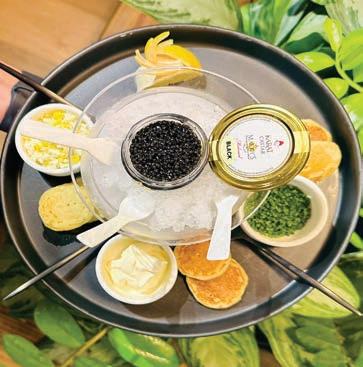

Family owned, Elliotts on Linden, showcases expertly crafted dishes made with regional and seasonal ingredients. Being ingrained in the community and utilizing our North Carolina produce is what makes Elliotts - Elliotts!
With a seasonal menu and a variety of meat, fish, and vegetarian options you’ll always have a reason to dine. Enjoy a craft cocktail from our bar or pair a bottle of hand selected wine with your meal.
Elliotts on Linden is the dining experience for all occasions, anniversary, birthday, celebration, or - just because! A great meal with great friends nourishes the soul and community.
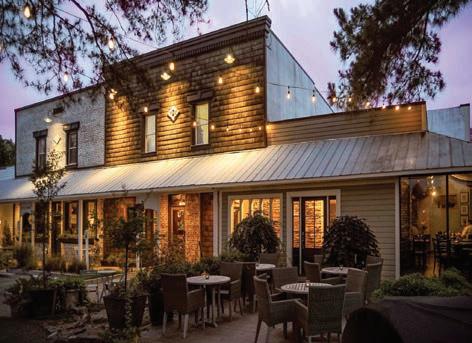

Kick back and enjoy weekend brunch at Pinehurst Brewing Company, where great food, craft beer, and a bit of history come together. Housed in the Village’s old steam plant, PBC serves up a relaxed atmosphere with unique flavors to match. Dig into the Smoked Brisket and Sweet Potato Biscuit Sandwich, drizzled with blackberry habanero glaze and topped with mango chimichurri, or go for the Pulled Pork Cornbread Waffle, piled high with housesmoked pork, coleslaw, and hickory BBQ sauce. Wash it down with a mimosa flight, garnished Bloody Mary, or one of our craft brews. Whether you’re here for the history, the hops, or just a great meal, brunch at PBC is worth the trip. Stop by Saturday and Sunday from 11 a.m. to 3 p.m.
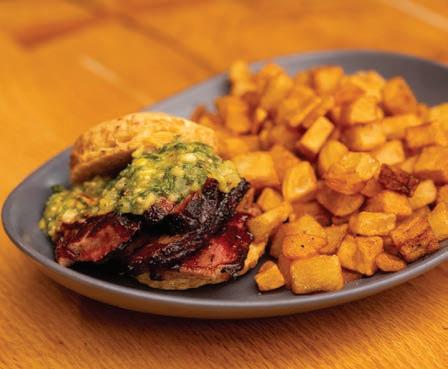













Table on the Green, helmed by the talented Chef Pias (Kamonwan) Pak, is a culinary treasure in Moore County, offering an exciting fusion of Thai, Asian, and American flavors. With a rich background that spans Bangkok, Japan, and Okinawa, Pias brings her passion for family recipes and cultural diversity to every dish. Since taking the reins in 2022, Table on the Green has quickly become a local favorite, consistently earning recognition as one of the Top 3 Thai restaurants in the Best of the Pines. The signature Lobster Pad Thai, a luxurious blend of authentic Thai flavors and succulent lobster, is just one of the highlights that makes dining here an unforgettable experience.
Whether you’re enjoying lunch, dinner, or Sunday brunch, Table on the Green offers a taste of culinary excellence in the heart of Pinehurst.





Satisfy your cravings at Embers BBQ, where smoked meats are the star of the show. Indulge in their tender, fall-off-the-bone spareribs, slow-cooked pulled pork and chicken, and mouthwatering, madeto-order smoked burgers. Brisket lovers can get their fix Tuesday through Saturday. Homemade sides like rich mac-n-cheese or creamy potato salad complete the meal.
Passionate about his BBQ, Chef/Owner David Bungarz got his start helping his father in the pits from a young age. David has the uncanny ability to create “melt in your mouth” homemade dishes at affordable prices.
Whether you’re a local or just visiting, Embers BBQ invites you to roll up your sleeves, dig in and experience true southern BBQ, served fresh every day.
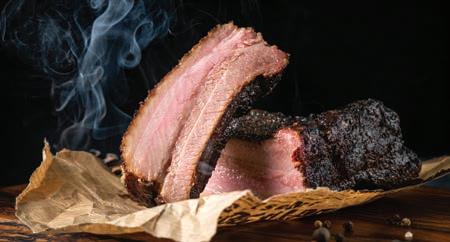


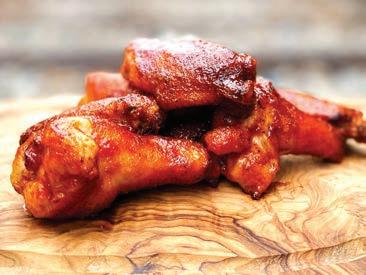
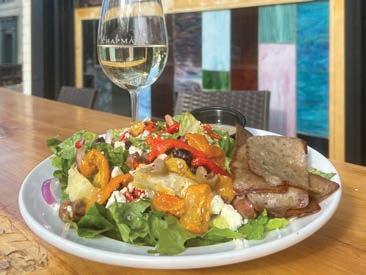

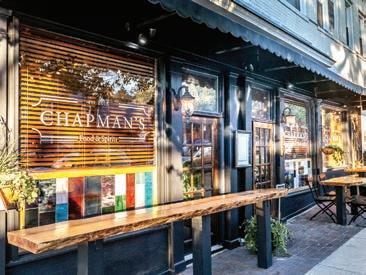
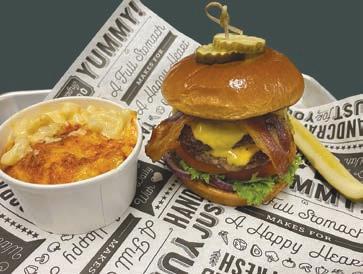





Chapman’s Food & Spirits takes pride in serving chef-driven American fare that keeps the community coming back for more. The menu is crafted for all tastes, featuring signature favorites like the bold and juicy Bacon Jam Burger. This mouthwatering burger features a blend of ground chuck, short rib and beef brisket topped with savory bacon jam, melted cheddar and fresh toppings on a toasted brioche bun.
If you’re looking for something to share, the Cajun Crawfish Fries are a must-try. These crispy fries are smothered in chipotle cream sauce and loaded with flavorful crawfish. It’s a local staple that’s wicked good!


From salads and hearty fare to daily specials and Chappy’s Kids menu, Chapman’s menu offers something for everyone, and every dish is cooked to order. Join them daily for lunch and dinner and experience the best of Chapman’s in a comfortable, casual atmosphere.


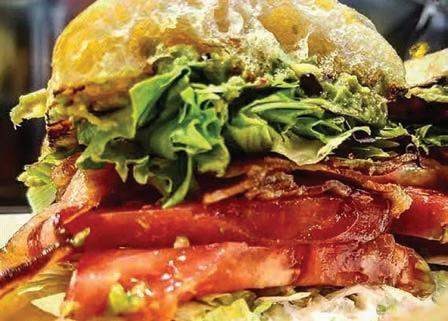

Midland Bistro, a local favorite for breakfast & lunch is known for its cozy atmosphere, delicious dishes, and friendly service. From unique sandwiches to decadent waffles, there is something to please every palate, along with daily specials. Their signature dish, Eggs Benedict, is offered in a variety of flavorful combinations, like the Southern Benedict. This dish is a flavorful twist on tradition with sausage patties and poached eggs atop a buttermilk biscuit — all topped with buttery hollandaise. It’s yummy y’all!

MONDAY - SATURDAY: 8:00AM - 2:30PM
SUNDAY BRUNCH: 9:00AM - 1:00PM
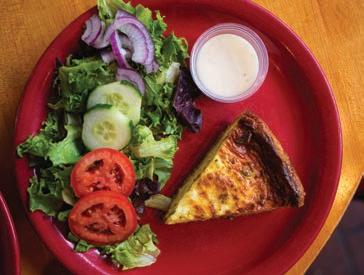

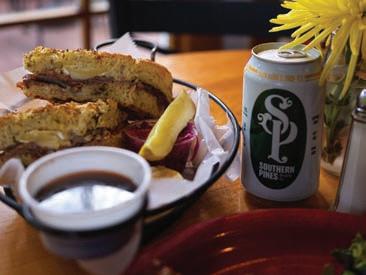

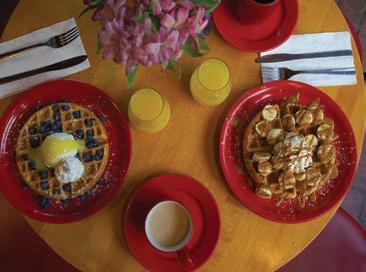

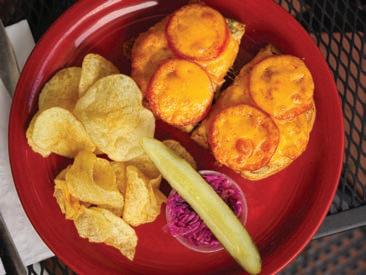






Discover the vibrant flavors of Mexico at Casa Santa Ana, the most authentic Mexican restaurant in Moore County, North Carolina. Family-owned and proudly serving the community for 11 years, we have two convenient locations, Seven Lakes and Pinehurst.
At Casa Santa Ana, every dish is freshly prepared daily to deliver the bold, traditional tastes that make Mexican cuisine unforgettable. From sizzling fajitas to savory enchiladas, every bite will transport you straight to Mexico.


Don’t miss our signature margaritas, served in generous 16-ounce glasses and guaranteed to delight your senses. Whether you’re joining us for a casual lunch, a relaxing evening dinner, or a special group gathering, Casa Santa Ana is the perfect destination.
Let us cater your next event with our authentic flavors that are sure to impress. Visit us today and experience the warmth, hospitality, and deliciousness that define Casa Santa Ana!




Drum & Quill has stepped out as much more than just a pub. New Executive Chef, Kat Wiggs offers a transitional menu with an American Southern Fusion, which includes crab cakes, chicken and waffles, seasonal vegetables, and cheesecakes on rotation. Her personal specialty is a seared pork loin with a blackberry balsamic reduction, but she’s also updated customer favorites, like the signature alpine burger. She creates comforting dishes with modern twists, using flavorful spices but keeping things simple.
Drum & Quill has stepped out as much more than just a pub. New Executive Chef, Kat Wiggs offers a transitional menu with an American Southern Fusion, which includes crab cakes, chicken and waffles, seasonal vegetables, and cheesecakes on rotation. Her personal specialty is a seared pork loin with a blackberry balsamic reduction, but she’s also updated customer favorites, like the signature alpine burger. She creates comforting dishes with modern twists, using flavorful spices but keeping things simple.
Drum & Quill has stepped out as much more than just a pub. New Executive Chef, Kat Wiggs offers a transitional menu with an American Southern Fusion, which includes crab cakes, chicken and waffles, seasonal vegetables, and cheesecakes on rotation. Her personal specialty is a seared pork loin with a blackberry balsamic reduction, but she’s also updated customer favorites, like the signature alpine burger. She creates comforting dishes with modern twists, using flavorful spices but keeping things simple.
Drum & Quill sources ingredients locally from Pinehurst Olive Oil Company, The Bakehouse, and Lazy Fox Lavender Farm, among others to create dishes that highlight quality products from the area.
Drum & Quill sources ingredients locally from Pinehurst Olive Oil Company, The Bakehouse, and Lazy Fox Lavender Farm, among others to create dishes that highlight quality products from the area.
Drum & Quill sources ingredients locally from Pinehurst Olive Oil Company, The Bakehouse, and Lazy Fox Lavender Farm, among others to create dishes that highlight quality products from the area.
Located in the heart of the village, Drum & Quill is a “public house,” intentionally small and cozy, providing a classic and comfortable atmosphere offering the largest spirits selection in the area.
Located in the heart of the village, Drum & Quill is a “public house,” intentionally small and cozy, providing a classic and comfortable atmosphere offering the largest spirits selection in the area.
Located in the heart of the village, Drum & Quill is a “public house,” intentionally small and cozy, providing a classic and comfortable atmosphere offering the largest spirits selection in the area.
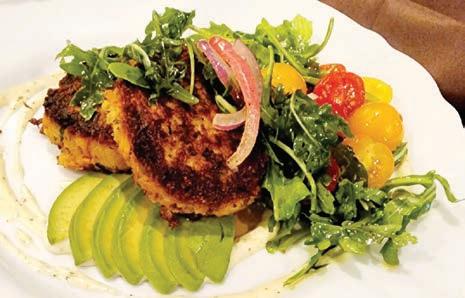









Busaba is a fusion Japanese restaurant specializing in comfort food with a modern twist. The menu features favorites like udon, curry ramen, meat cutlets, and gyoza dumplings, alongside refreshing tempura udon noodle soup, crispy meat cutlets with a mild curry sauce that even kids can enjoy, juicy Japanese hamburger steak, and flavorful duck curry ramen. They also offer a virety of rice options, including white, brown, and black berry.
Committed to using wholesome ingredients and offering vergetarian options, Busaba ensures guests feel satisfied and nourished after their meal. The cozy and relaxed atmosphere welcomes everyone to unwind & enjoy.

To add an event, email us at
Although conscientious effort is made to provide accurate and up-to-date information, all events are subject to change and errors can occur! Please call to verify times, costs, status and location before planning or attending any events.
SATURDAY, MARCH 1
NATURE CONNECTION. 10 - 11 a.m. Kids of all ages can come connect with nature. Reservoir Park, 300 Reservoir Park Drive, Southern Pines. Info: www.southernpines.net.
KID’S SATURDAY. 10 a.m. - 12 p.m. Families are invited to a monthly themed craft event to socialize and get creative. Geared toward ages 3 - 10. Given Memorial Library, 150 Cherokee Road, Pinehurst. Info: (910) 295-3642 or www.vopnc.org.
FAMILY FUN SERIES. 5 - 7:20 p.m. The Colorful Hat Circus and Variety Show features magic, stage illusions, juggling and acrobatics. Owens Auditorium, 3395 Airport Road, Pinehurst. Info: www.ticketmesandhills.com.
PICKLEBALL. 5:30 - 11 p.m. Ages 18 and older can compete in a cosmic pickleball tournament. Recreation Center, 160 Memorial Park Court, Southern Pines. Info: www.southernpines.net.
CASINO ROYALE GALA. 6 - 10 p.m. Join us for a night of adults-only fun at the tables while supporting the students of St. John Paul II Catholic School. The evening includes dinner, drinks, game tables, entertainment, great company and a wonderful cause. Cost is $150 per person. Country Club of North Carolina ballroom, 1600 Morganton Road, Pinehurst. Info: www.sjp2.rsvpify.com.
CAROLINA SHAG DANCE. 7 - 10 p.m. Put on your dancing shoes and join us for the Moore Area Shag Society monthly dance. Doors open at 6:30 p.m. Cash bar. Down Memory Lane 161 Dawkins St., Aberdeen. Info: (919) 345-4105.
SUNDAY, MARCH 2
WRITING GROUP. 3 p.m. Interested in creating fiction, nonfiction, poetry or comics? Come to the Sunday Afternoon Writing Group. Connect with other writers and artists, chat about your craft, and get feedback about your work. All levels welcome. Southern Pines Public Library, 170 W. Connecticut Ave., Southern Pines. Info: lholden@sppl.net.
MONDAY, MARCH 3
QUILTS OF VALOR. 12 - 4 p.m. Quilts of Valor meets the first Monday of each month to create lap quilts made especially for veterans. If you sew, bring your machine. If you don’t sew, you can iron or cut out fabrics for new designs. This is a free program. Moore County Senior Enrichment Center, 8040 U.S. 15-501, West End.
TUESDAY, MARCH 4
BRAIN FITNESS. 10 - 11 a.m. Adults 18 and older are invited to enjoy short relaxation and brain enhancement exercises. Eve Gaskell will be the instructor. Free of charge. Douglass Community
Center, 1185 W. Pennsylvania Ave., Southern Pines. Info: (910) 692-7376.
ALCOHOL INK ART. 11 a.m. - 12 p.m. Adults 55 and older can enjoy this easy and beautiful alcohol ink-on-tile art class. Free of charge. Douglass Community Center, 1185 W. Pennsylvania Ave., Southern Pines. Info: (910) 692-7376.
KIDS ROCK. 4:30 - 5:25 p.m. Kids ages 7 - 12 can come learn about music. There will be six classes. Whitehall, 490 Pee Dee Road, Southern Pines. Info: (910) 692-7376.
WEDNESDAY, MARCH 5
ACTIVE ADVENTURES. 10 - 11 a.m. Kids ages 2 - 5 can get out their energy with fun adventures. Recreation Center, 160 Memorial Park Court, Southern Pines. Info: (910) 692-7376.
HOMESCHOOL FUN. 11:15 a.m. - 12:15 p.m. Kids ages 5 - 13 can hang out and have fun with other homeschoolers. Recreation Center, 160 Memorial Park Court, Southern Pines. Info: (910) 692-7376.
THURSDAY, MARCH 6
TUMBLING. 3 - 3:45 p.m. Kids ages 3 - 7 can tumble under the stars. Train House, 482 E. Connecticut Ave., Southern Pines. Info: www. southernpines.net.
SUPPORT GROUP. 5:30 - 7:30 p.m. The Sandhills Chronic Kidney Disease Support Group meets the first Thursday of each month. Clara McLean House, Shadowlawn Room, 20 First Village Drive, Pinehurst. Info: angela@sandhillsckd.com or kathy@sandhillsckd.com.
FRIDAY, MARCH 7
HORSE TRIALS. 7 a.m. Enjoy the Southern Pines horse trials through March 8. Carolina Horse Park, 2814 Montrose Road, Raeford. Info: www.carolinahorsepark.com.
HEALTH SYMPOSIUM. 10 a.m. - 12 p.m. Women of the Pines is hosting its third annual health symposium with the presentation “A Journey to a Healthier Lifestyle.” Free admission, registration required. Pinehurst Village Hall, 395 Magnolia Road, Pinehurst. Info: www.womenofthepines.org.
LUNCH BUNCH. 11:30 a.m. Adults 55 and older are invited to dine on different cuisines each month visiting restaurants in the area. Carpool with friends or meet at the restaurant. Dining locations will be chosen the week before. Info: (910) 692-7376.
OPENING RECEPTION. 5 - 7 p.m. The exhibit “Abstracted” will feature abstract paintings created in a variety of mediums. The exhibit runs through March 28. Artists League of the Sandhills, 129 Exchange St., Aberdeen. Info: www.artistleague.org.
KARAOKE. 7 - 10 p.m. Enjoy a night of cosmic karaoke. Free and open to the public. Adults only after 9 p.m. Starworks Cafe & Taproom, 100 Russell Drive, Star. Info: www.StarworksNC.org.
TEA WITH POTTERS. 10 a.m. - 5 p.m. Discover your favorite teapot on a 5-mile driving tour through Seagrove while enjoying a tea-tasting experience shopping along N.C. Pottery Highway. Each shop will have homemade treats and samples from The Table and Seagrove Cafe and tea samples from Carriage House Tea. Info: www.teawithseagrovepotters.com.
BRUNCH. 11 a.m. The Habitat Women Build Committee is hosting an empowerment brunch. Jenni Cunningham will be the guest speaker. A portion of the ticket price goes directly to the 2025 Women Build home. Pinehurst Country Club, 1 Carolina Vista Drive, Pinehurst. Info and tickets: www.sandhillshabitat.org.
LIVE MUSIC. 6:30 - 8:30 p.m. Live music from Scarred for Life. Free and open to the public. Starworks Cafe & Taproom, 100 Russell Drive, Star. Info: www.StarworksNC.org.
CRAFT DAYS. Children and their families can come by the library for Drop-in Craft Days and work on crafts and coloring at their own pace. Southern Pines Public Library, 170 W. Connecticut Ave., Southern Pines. Info: (910) 692-8235 or www. sppl.net.
SUNDAY, MARCH 9
CONCERT. 7 p.m. Guitarist and vocalist Grace McNally crosses genres and cultures with her a original music of classical repertoire, jazz standards and traditional folk songs. Cash bar. Tickets start at $27.50. Weymouth Center for the Arts & Humanities, 555 E. Connecticut Ave., Southern Pines. Info: www.weymouthcenter.org.
MAKERS PANEL. 2:30 p.m. Join local artisans who will share their creative journeys and expertise at “Crafted in Community — Makers Panel & Market.” After the discussion, browse a mini market offering a selection of handmade goods for sale. Southern Pines Public Library, 170 W. Connecticut Ave., Southern Pines. Info: (910) 692-8235 or www. sppl.net.
MONDAY, MARCH 10
SINGING. 6 - 7 p.m. Kids ages 7 - 10 can explore their voices. Train House, 482 E. Connecticut Ave., Southern Pines. Info: www.southernpines.net.
CHOIR. 7 - 8 p.m. Kids ages 11 - 15 can participate in a musical theater choir. Train House, 482 E. Connecticut Ave., Southern Pines. Info: www. southernpines.net.
TUESDAY, MARCH 11
HATHA YOGA. 10 - 11 a.m. Adults 55 and older can increase flexibility, balance, stability and muscle tone while learning the basic principles of alignment and breathing. You may gain strength, improve circulation and reduce chronic pain practicing gentle yoga postures and mindfulness. Free of charge. Douglass Community Center, 1185 W. Pennsylvania Ave., Southern Pines. Info: (910) 692-7376.
AARP TALK. 12 - 12:30 p.m. Adults 55 and older are invited to join AARP for a fraud talk. Free of charge. Douglass Community Center, 1185 W. Pennsylvania Ave., Southern Pines. Info: (910) 692-7376.
WEDNESDAY, MARCH 12
SENIOR EXCURSION. 8:30 a.m. - 3 p.m. Adults 55 and older are invited to travel to the Richard Petty Museum. Lunch will be at American Roadhouse following the museum tour. Cost is $33 for residents and $46 for non-residents. Info: (910) 692-7376.
BOOK EVENT. 6 - 7 p.m. The Country Bookshop welcomes Ada Calhoun talking about her book Crush. The Country Bookshop, 140 N.W. Broad St., Southern Pines. Info: www.ticketmesandhills.com.
TECH HOUR. 11 a.m. Attend a walk-in tech hour to get hands-on help with your tech questions. Whether you’re new to computers, want to learn more about your smartphone, or want to learn how to use your eReader, library staff will guide you. Southern Pines Public Library, 170 W. Connecticut Ave., Southern Pines. Info: msilva@sppl.net.
THURSDAY, MARCH 13
GARDEN TOUR. 10 a.m. With the spring equinox approaching, explore all of the changes in the gardens. Free event. Limit 15 people. Sandhills Horticultural Gardens, 3245 Airport Road, Southern Pines. Info: www.sandhills.edu/ horticultural-gardens.
CORNHOLE. 12 - 1 p.m. Adults 55 and older are invited to have some fun and games with friends. Douglass Community Center, 1185 W. Pennsylvania Ave., Southern Pines. Info: (910) 692-7376.
PLANT WORKSHOP. 1 - 3 p.m. Herbalist and holistic health coach Kate Smith returns to share her expertise about wild plants. This workshop teaches you the fundamentals of wild medicinal and edible plant identification and usage. Limit 20 people. Sandhills Horticultural Gardens, 3245 Airport Road, Southern Pines. Info: www.sandhills.edu/horticultural-gardens.
WRITER IN RESIDENCE TALK. 3:30 p.m. John Amen is the author of five collections of poetry, including Illusion of an Overwhelm, finalist for the 2018 Brockman-Campbell Award. He founded and continues to edit Pedestal Magazine. Free and open to the public. Weymouth Center for the Arts & Humanities, 555 E. Connecticut Ave., Southern Pines. Info: www.weymouthcenter.org.
HORSE EVENT. The Settlers Run Farm Carolina International CCI 4S and HT. Trials run through March 16. Carolina Horse Park, 2814 Montrose Road, Raeford. Info: www.carolinahorsepark.com.
HOT GLASS COLD BEER. 5:30 p.m. Esteban Salazar will be the guest glass artist. There will also be live music from Emily Burdette. Starworks Cafe & Taproom, 100 Russell Drive, Star. Info: www. StarworksNC.org.
FRIDAY, MARCH 14
HEALTH PROGRAM. 10:30 a.m. Marisa Ramos of the Moore County Department of Health will present a “zero session” introducing her “A Matter of Balance” class. The class is an award-winning program designed to manage falls and increase activity levels. Southern Pines Public Library, 170 W. Connecticut Ave., Southern Pines. Info: (910) 692-8235 or www.sppl.net.
SATURDAY, MARCH 15
WORKSHOP. 9 a.m. Welding and Beyond: Intermediate Fabrication Workshop with instructor, Mac Metz. Starworks Cafe & Taproom, 100 Russell Drive, Star. Info: www.StarworksNC.org.
FISHING 101. 9 - 10:30 a.m. Kids ages 5 - 16 can learn basics of fishing. Reservoir Park, 300 Reservoir Park Drive, Southern Pines. Info: www. southernpines.net.
PARADE. 10 a.m. The village of Pinehurst will flood the streets with Irish spirit during the annual Saint Patrick’s Day parade. James W. Tufts Memorial Park, 1 Village Green Road W., Pinehurst. Info: www.vopnc.org.
FLOWER WORKSHOP. 1 - 3 p.m. LB’s Farm is hosting a workshop where you will tour the farm, learn about daffodils and create your own flower arrangement. LB’s Farm, 965 Pinewood Church Road, Cameron. Info: www.ticketmesandhills.com.
MUSIC PERFORMANCE. 5 p.m. Scott Moreau stars in, “Diamond: The Songs of Neil Diamond,” presented by the Sandhills Repertory Theatre. There will be a second performance at 8 p.m. and an additional show on March 16 at 2 p.m. Sunrise Theater, 250 N.W. Broad St., Southern Pines. Info: www.sandhillsrep.org or www.sunrisetheater.com.
TRIVIA. 7 p.m. Play a round of trivia. Free and open to the public. Starworks Cafe & Taproom, 100 Russell Drive, Star. Info: www.StarworksNC.org.
STORYTIME. 10:15 a.m. Saturday Storytime is a once-a-month program for children from birth to 5. Join in for stories, songs, rhymes and smiles where caregivers and young children can interact and explore the fun of language and early literacy. There are space constraints for this indoor story time. Southern Pines Public Library, 170 W. Connecticut Ave., Southern Pines. Info: www.sppl.net.
MONDAY, MARCH 17
PHOTO CLUB. 7 p.m. Sandhills Photography Club monthly meeting will be about “Church Architecture Photography: From Hallowed Ground to the Heavens,” by Brian Osborne. Guests are welcome. Sandhills Horticultural Gardens Visitors Center, 3245 Airport Road, Southern Pines. Info: www.sandhillsphotoclub.org.
TUESDAY, MARCH 18
BRAIN FITNESS. 10 - 11 a.m. Adults 18 and older are invited to enjoy short relaxation and brain enhancement exercises, ending with a mindfulness practice. Eve Gaskell will be the instructor. Free of charge. Douglass Community Center, 1185 W. Pennsylvania Ave., Southern Pines. Info: (910) 692-7376.
BINGO. 11 a.m. - 12 p.m. Adults 55 and older are invited to play 10 games of bingo. Cost is $4 for residents and $6 for non-residents. Douglass Community Center, 1185 W. Pennsylvania Ave., Southern Pines. Info: (910) 692-7376.
CANVAS ART. 11 a.m. - 12 p.m. Adults 55 and older can enjoy this step-by-step tutorial with canvas art. Free of charge. Douglass Community Center, 1185 W. Pennsylvania Ave., Southern Pines. Info: (910) 692-7376.
BOOK CLUB. 2 p.m. The James Boyd Book Club meets and will be led by Iris Angle and Amy Rotting. The group will continue to honor North Carolina authors and include a range of genres of books with ties to N.C. or the Weymouth Center. Free Admission, Registration requested. Weymouth Center for the Arts & Humanities, 555 E. Connecticut Ave., Southern Pines. Info: www. weymouthcenter.org.
IRISH CELEBRATION SHOW. 7 - 9 p.m. Enjoy a show starring Andy Cooney that includes Ireland’s music, song, comedy and dance. Featuring The Guinness Irish Band and Emerald Fire Irish Dance. Fair Barn, 200 Beulah Hill Road S., Pinehurst. Info and tickets: www.cooneyshows.simpletix.com.







TRY IT TUESDAY. 4 p.m. Ages 11-15 are invited to “Try It Tuesday,” putting viral Tik-Tok and Pinterest art techniques to the test. Southern Pines Public Library, 170 W. Connecticut Ave., Southern Pines. Info: www.sppl.net
WEDNESDAY, MARCH 19
FLOWER WORKSHOP. 10 a.m. - 12 p.m. LB’s Farm is hosting a workshop where you will tour the farm, learn about daffodils and create your own flower arrangement. LB’s Farm, 965 Pinewood Church Road, Cameron. Info: www.ticketmesandhills.com.
BOOK EVENT. 6 - 7 p.m. The Country Bookshop welcomes Eddie Huffman to discuss his book Doc Watson: A Life in Music. The Country Bookshop, 140 N.W. Broad St., Southern Pines. Info: www.ticketmesandhills.com.
THURSDAY, MARCH 20
CIVIL WAR ROUND TABLE. 6:30 p.m. The guest speaker will be military historian and author Gary Livingston, with a presentation on “The Best Men the South Could Boast: The Fall of Fort McAllister.” Meeting starts at 7 p.m. Open to the public. Civic Club, corner of Pennsylvania and Ashe St., Southern Pines. Info: (910) 246-0452 or mafarina@aol.com.
OPEN MIC NIGHT. 7 p.m. Open mic night hosted by Rob Brady. Starworks Cafe & Taproom, 100 Russell Drive, Star. Info: www.StarworksNC.org.


FRIDAY, MARCH 21
STEM. 12:30 - 3:30 p.m. Kids in grades K - 6 can learn STEM fundamentals. Train Station, 235 N.W. Broad St.., Southern Pines. Info: www.southernpines.net.
NIGHT OUT. 6 - 8 p.m. Parents can drop off their kids ages 4 – 13 and enjoy a night out. Train House, 482 E. Connecticut Ave., Southern Pines. Info: www.southernpines.net.
HOMESCHOOL HANGOUT. 2:30 - 4:30 p.m. Homeschool Hangout is a monthly drop-in space for homeschooling families in grades K-12. Meet with others and work on activities based on the theme of the month. There will be some activities and resources available, but please bring your own as well. Southern Pines Public Library, 170 W. Connecticut Ave., Southern Pines. Info: www.sppl.net.
SATURDAY, MARCH 22
BATTLESHIP TRIP. 8 a.m. - 5 p.m. Travel to the coast to visit the battleship North Carolina. Lunch will be at Chick-fil-A afterward. Cost is $36 for residents and $50 for non-residents. Bus departs from the Recreation Center Gym, 160 Memorial Park Court, Southern Pines. Info: (910) 692-7376.
WORKSHOP. 9 a.m. “Forge Your Own Grill Tools” in a beginner blacksmithing workshop. No experience necessary. Starworks Cafe & Taproom, 100 Russell Drive, Star. Info: www. StarworksNC.org.
SPRING INTO READING. 10 a.m. - 12 p.m. The second annual “Spring into Reading” event celebrates national reading month. Readers and crafts will be set up around the grounds. Free admission. Registration appreciated. Weymouth Center for the Arts & Humanities, 555 E. Connecticut Ave., Southern Pines. Info: www.weymouthcenter.org.
LIVE MUSIC. 6:30 - 8:30 p.m. Live music from Big Dumb Hick. Free and open to the public. Starworks Cafe & Taproom, 100 Russell Drive, Star. Info: www.StarworksNC.org.
CRAFT DAYS. Children and their families can come by the library for Drop-in Craft Days and work on crafts and coloring at their own pace. Southern Pines Public Library, 170 W. Connecticut Ave., Southern Pines. Info: (910) 6928235 or www.sppl.net.
SUNDAY,
JAZZ SERIES. 2 - 4 p.m. Listen to live jazz by Sarah Hanahan, a New York City-based alto saxophonist. Bring your own blanket, chairs and a picnic. Enjoy a cash bar with mimosas, beer, wine and nonalcoholic beverages available. Weymouth Center for the Arts & Humanities, 555 E. Connecticut Ave., Southern Pines. Info: www.weymouthcenter.org.
MAKERS PANEL. 2:30 p.m. Join local artisans who will share their creative journeys and expertise at “Crafted in Community — Makers Panel & Market.” After the discussion, browse a mini market offering a selection of handmade goods for sale. Southern Pines




Public Library, 170 W. Connecticut Ave., Southern Pines. Info: (910) 692-8235 or www.sppl.net.
MONDAY, MARCH 24
CHARITY GOLF CHAMPIONSHIP. The Kelly Cup Golf Championship benefiting the Sandhills Children’s Center includes a round of golf with a meal provided afterward. There is an auction of golf rounds and trips, as well as Angel Tees with therapeutic “wish list” items. Forest Creek Golf Club, 100 Forest Creek Drive, Pinehurst. Info: (910) 692-3323 or www.sandhillschildrenscenter.org.
TUESDAY, MARCH 25
JAM SESSION. 6 - 9 p.m. Bring your own instrument and beverage or just enjoy the music in the Boyd House Great Room. All skill levels and all instruments are welcome. Open to the public. Registration appreciated. Weymouth Center for the Arts & Humanities, 555 E. Connecticut Ave., Southern Pines. Info: www.weymouthcenter.org.
WEDNESDAY, MARCH 26
LUNCH ‘N’ LEARN. 10 a.m. Sandhills Woman’s Exchange Lunch ‘n’ Learn program features The Pilot contributor and writer Joyce Reehling with a talk on “Adventures in Africa.” Tickets are $30 per person and include a chef Katrina lunch, beverage and dessert. Sandhills Woman’s Exchange, 15 Azalea Road, Pinehurst. Info: (910) 295-4677.
GARDENING PRESENTATION. 10 a.m. Author Brie Arthur demonstrates how to have culinary and floral harmony as she reveals the art of pairing food and flowers of the region. Free event. Limit 16 people. Sandhills Horticultural Gardens, 3245 Airport Road, Southern Pines. Info: www.sandhills.edu/horticultural-gardens.
BOOK EVENT. 11 a.m. - 12 p.m. Elaine Neil Orr discusses her new book, Dancing Woman. Weymouth Center for the Arts & Humanities, 555 E. Connecticut Ave., Southern Pines. Info: www. ticketmesandhills.com.
THURSDAY, MARCH 27
WELLNESS CLASSES. 10 - 11:30 a.m. Adults 18 and older are invited to learn about different educational topics to improve overall mind, body and spirit. Free of charge. Douglass Community Center, 1185 W. Pennsylvania Ave., Southern Pines. Info: (910) 692-7376.
MUSIC. 7 p.m. Bring your instruments and join this old-time jam. Starworks Cafe & Taproom, 100 Russell Drive, Star. Info: www.StarworksNC.org.
FRIDAY, MARCH 28
SPRING FLING. 5:30 - 7:30 p.m. Ages 3 - 12 can celebrate the arrival of spring with games, face painting, bounce houses, entertainment and more. Concessions will be available for purchase.


Children must be accompanied by an adult. Free of charge. Downtown Park, Southern Pines. Info: (910) 692-7376.
OUTDOOR MOVIE. 7:30 p.m. Come alone or bring the entire family to watch Moana 2. Concessions will be available for purchase. Don’t forget to bring a blanket or chair. Free of charge. Downtown Park, Southern Pines. Info: (910) 692-7376.
MAINSTAGE SERIES. 8:30 p.m. Garrison Keillor Tonight is an evening of stand-up, storytelling, audience song and poetry. One man, one microphone. Owens Auditorium, 3395 Airport Road, Pinehurst. Info: www.ticketmesandhills.com.
SATURDAY, MARCH 29
ART EXHIBIT. 10 a.m. - 4 p.m. The Garden Club of the Sandhills hosts the “Blooming Art” exhibit featuring professional floral designers, local garden club members and local artists. Tickets are $20. Campbell House, 482 E. Connecticut Ave., Southern Pines. Info: www.ticketmesandhills.com.
SPRING FESTIVAL. 12 - 4 p.m. The town of Vass is having a spring festival with music, food, vendors and kids’ activities. Free and open to the public. Seaboard St., Vass. Info: www.townofvassnc.gov.
LIVE MUSIC. 6:30 - 8:30 p.m. Live music from Bad Penny. Free and open to the public. Starworks Cafe & Taproom, 100 Russell Drive, Star. Info: www.StarworksNC.org.



MONDAY, MARCH 31
FAMILY FUN SERIES. 7 p.m. Experience The All New Wizard of Oz on Ice. Owens Auditorium, 3395 Airport Road, Pinehurst. Info: www.ticketmesandhills.com.
SATURDAY, MARCH 29
BACKYARD BIRDS. 10:30 a.m. Pat Updegraff will discuss the birds you can spot around Southern Pines and share her experiences of participating in citizen science projects. Southern Pines Public Library, 170 W. Connecticut Ave., Southern Pines. Info: (910) 692-8235 or www.sppl.net.
SUNDAY, MARCH 30
STEAM. 2:30 - 3:30 p.m. Elementary-aged children and their caregivers are invited to learn about topics in science, technology, engineering, art and math, and to participate in STEAM projects and activities. This month, explore space with “NASA Jon.” Southern Pines Public Library, 170 W. Connecticut Ave., Southern Pines. Info: (910) 692-8235 or kbroughey@sppl.net.
MONDAYS
WORKSPACES. 7 a.m. - 3 p.m. The Given Tufts Bookshop has a new pop-in co-workspace open on Mondays and Thursdays in the upstairs conference


room. Bookshop floor and private meeting room by reservation only. Info: www.giventuftsfoundation. com.
WORKOUTS. 8:30 a.m. - 4:30 p.m. Adults 55 and older are invited to get their workout on. Open Monday through Friday. Cost for six months: $15/ resident; $30/non-resident. Douglass Community Center, 1185 W. Pennsylvania Ave., Southern Pines. Info: (910) 692-7376.
CHAIR YOGA. 9 - 10 a.m. For adults 55 and older. Help offset body aches encountered with desk work. This is an accessible yoga class for bodies not able to easily get up from and down to the floor. Do standing or sitting in a chair. Douglass Community Center, 1185 W. Pennsylvania Ave., Southern Pines. Info: (910) 692-7376.
STRENGTH AND BALANCE WORKOUT. 1111:45 a.m. Adults 55 and older are invited to enjoy a brisk workout that focuses on balance and strength. Free of charge. Douglass Community Center, 1185 W. Pennsylvania Ave., Southern Pines. Info: (910) 692-7376.
RESTORATIVE YOGA. 12 p.m. For adults 55 and older. Practice movements that may help alleviate pain, improve circulation and well-being. Bring your own mat. Free of charge. Douglass Community Center, 1185 W. Pennsylvania Ave., Southern Pines. Info: (910) 692-7376.
GAME ON. 1 p.m. For adults 55 and older. Play various games such as corn hole, badminton, table
tennis, shuffleboard, trivia games and more. Each week enjoy a different activity to keep moving and thinking. Compete with friends and make new ones all for free. Douglass Community Center, 1185 W. Pennsylvania Ave., Southern Pines. Info: (910) 692-7376.
TAI CHI. 1:30 - 2:30 p.m. For adults 55 and older. Improve balance, relaxation, vitality and posture to reduce the rate of falls in older adults. Free of charge. Douglass Community Center, 1185 W. Pennsylvania Ave., Southern Pines. Info: (910) 692-7376.
BRIDGE. 1:30 - 4:30 p.m. For adults 55 and older. Enjoy games of bridge with friends. Douglass Community Center, 1185 W. Pennsylvania Ave., Southern Pines. Info: (910) 692-7376.
PLAYFUL LEARNING. 10 a.m. - 2 p.m. Interact with other children at a drop-in, open educational playtime for ages 0 - 3 years. Given Memorial Library, 150 Cherokee Road, Pinehurst. Info: (910) 295-3642.
BABY RHYMES. 10:15 a.m. Baby Rhymes is specially designed for the youngest learners (birth2) and their caregivers. Repetition and comforting movements make this story time perfect for early development and brain growth. There will be a duplicate session at 10:45 a.m. An active library card is required. Southern Pines Public Library, 170









W. Connecticut Ave., Southern Pines. Info: (910) 692-8235 or www.sppl.net.
GAME DAY. 12 p.m. Enjoy bid whist and other cool games all in the company of great friends. For adults 55 and older. Douglass Community Center, 1185 W. Pennsylvania Ave., Southern Pines. Info: (910) 692-7376.
CHESS. 1:30 - 5 p.m. Join a chess group for players of all levels. This is a free program. Moore County Senior Enrichment Center, 8040 U.S. 15-501, West End.
LINE DANCE. 4:45 p.m. Put on your dancing shoes and line dance in a free program designed for beginners. Moore County Senior Enrichment Center, 8040 U.S. 15-501, West End.
WEDNESDAYS
CHAIR AEROBICS. 10 - 11 a.m. For adults 55 and older. Party up a sweat to great music through the ages, standing or chair dancing to an energizing, low-impact aerobic workout. Douglass Community Center, 1185 W. Pennsylvania Ave., Southern Pines. Info: (910) 692-7376.
BRAIN BOOST. 10 - 11 a.m. A free program to test your memory while creating new brain connections. Moore County Senior Enrichment Center, 8040 U.S. 15-501, West End.
KNITTING. 10 - 11 a.m. Learn how to knit or just
come enjoy knitting with other people. This is a free program. Moore County Senior Enrichment Center, 8040 U.S. 15-501, West End.
BABY STORYTIME. 10 - 11 a.m. Have fun developing the foundation for your baby’s later reading with stories, songs and play. Open to parents and caregivers of infants from newborn to 24 months. Moore County Library, 101 W. Saunders St., Carthage. Info: (910) 947-5335.
LEARN AND PLAY. 10 a.m. - 12 p.m. Come to an open play date with your toddler or preschooler. There will be developmental toys and puzzles as well as early literacy tips on display for parents and caregivers to incorporate into their daily activities. Southern Pines Public Library, 170 W. Connecticut Ave., Southern Pines. Info: (910) 692-8235 or www. sppl.net.
IMPROV ACTING CLASS. 11 a.m. - 12 p.m. Adults 55 and older can sign up for a free improvisational acting class. Douglass Community Center, 1185 W. Pennsylvania Ave., Southern Pines. Info: (910) 692-7376.
PIANO. 11 a.m. - 12 p.m. Join Flint Long to play piano or just listen. This is a free program. Moore County Senior Enrichment Center, 8040 U.S. 15501, West End.
LINE DANCING. 12 - 1 p.m. Looking for new ways to get your daily exercise? Try line dancing. For adults 55 and older. Douglass Community Center,
1185 W. Pennsylvania Ave., Southern Pines. Info: (910) 692-7376.
CHAIR VOLLEYBALL. 1 - 2 p.m. For adults 55 and older. Get fit while having fun. Free to participate. Douglass Community Center, 1185 W. Pennsylvania Ave., Southern Pines. Info: (910) 692-7376.
BRIDGE. 1:30 - 4:30 p.m. For adults 55 and older. Enjoy games of bridge with friends. All materials included. Douglass Community Center, 1185 W. Pennsylvania Ave., Southern Pines. Info: (910) 692-7376.
DANCE. 2 - 2:30 p.m. For adults 55 and older. Instructor Maria Amaya teaches dance fitness in a class designed for anyone who wants to gently and gradually increase their cardio function, mobility and balance while having fun at the same time. Free of charge. Douglass Community Center, 1185 W. Pennsylvania Ave., Southern Pines. Info: (910) 692-7376.
LINE DANCING. 2 p.m. The town of Vass will host line dancing for seniors every other Wednesday. Cost is $5 per session. Vass Town Hall, 140 S. Alma St., Vass. Info: www.townofvassnc.gov.
TAI CHI. 2 - 3 p.m. For adults 55 and older. Improve balance, relaxation, vitality and posture to reduce the rate of falls in older adults. Free of charge. Douglass Community Center, 1185 W. Pennsylvania Ave., Southern Pines. Info: (910) 692-7376.

IMPROVISATIONAL ACTING. 3 - 4 p.m.
For adults 55 and older. Explore acting, unleash creativity through a variety of roles, embrace the unexpected and share some laughter together. Free of charge. Douglass Community Center, 1185 W. Pennsylvania Ave., Southern Pines. Info: (910) 692-7376.
LIBRARY PROGRAM. 3:30 p.m. At The Library After School (ATLAS) is an after-school program for K - 2nd graders who enjoy activities, crafts, stories and meeting new friends. Southern Pines Public Library, 170 W. Connecticut Ave., Southern Pines. Info: (910) 692-8235 or www.sppl.net.
TAI CHI. 6:30 p.m. Learn tai chi. There is no age limit and the classes are open to the public. Cost is $10 per class. Seven Lakes West Community Center, 556 Longleaf Drive, Seven Lakes. Info: (910) 400-5646.
THURSDAYS
WORKSPACES. 7 a.m. - 3p.m. The Given Tufts Bookshop has a new pop-in co-workspace open on Mondays and Thursdays in the upstairs conference room. Bookshop floor and private meeting room by reservation only. Info: www. giventuftsfoundation.com.
MOORE COUNTY FARMERS MARKET. 9 a.m. - 1 p.m. The year-round market features “producer only” vendors within a 50-mile radius
providing fresh, local and seasonal produce, fruits, pasture meats, eggs, potting plants, cut flowers and local honey. Crafts, baked goods, jams and jellies are also available. Market is located at the Armory Sports Complex, 604 W. Morganton Road, Southern Pines.
GIVEN STORY TIME. 10 a.m. Bring your preschooler to enjoy stories, songs and activities. Given Memorial Library, 150 Cherokee Road, Pinehurst. Info: (910) 295-3642.
BALANCE AND FLEXIBILITY. 10 - 11 a.m. Adults 55 and older are invited to enjoy a class that may reduce the risk of taking a tumble while increasing the ability to recover if they do. Free of charge. Douglass Community Center, 1185 W. Pennsylvania Ave., Southern Pines. Info: (910) 692-7376.
MUSIC AND MOTION. 10:15 and 10:45 a.m. Does your toddler like to move and groove? Join Music and Motion to get those wiggles out and work on gross and fine motor skills. For ages 2 - 5. An active library card is required. Southern Pines Public Library, 170 W. Connecticut Ave., Southern Pines. Info: (910) 692-8235 or www. sppl.net.
CROCHET CLUB. 11 a.m. - 12 p.m. Adults 55 and older are invited to bring friends to create fun designs and memories. Supplies are on site. Free of charge. Douglass Community Center,




1185 W. Pennsylvania Ave., Southern Pines. Info: (910) 692-7376.
ZUMBA. 11 a.m. - 12 p.m. Get and stay fit by joining this free Zumba dance workout series for adults 55 and older.. Douglass Community Center, 1185 W. Pennsylvania Ave., Southern Pines. Info: (910) 692-7376.
GENTLE YOGA. 12:30 - 1:30 p.m. Unwind, recharge and find peace in your week. For adults 55 and older. Free of charge. Douglass Community Center, 1185 W. Pennsylvania Ave., Southern Pines. Info: (910) 692-7376.
CHESS AND MAHJONG. 1 p.m. Bring a board and a friend. For adults 55 and older. Douglass Community Center, 1185 W. Pennsylvania Ave., Southern Pines. Info: (910) 692-7376.
CABIN TOURS. 1 - 4 p.m. The Moore County Historical Association’s Shaw House grounds, cabins and gift shop are open for tours and visits. The restored tobacco barn features the history of children’s roles in the industry. Docents are ready to host you and the cabins are open Thursdays, Fridays and Saturdays. Shaw House, 110 W. Morganton Road, Southern Pines. Info: (910) 692-2051 or www.moorehistory.com.
IMPROVERS LINE DANCE. 3 - 5:30 p.m. Put on your dancing shoes and line dance. This is a free program. Moore County Senior Enrichment Center, 8040 U.S. 15-501, West End.















LITTLE U. 3:30 p.m. Join Little U, Southern Pines Public Library’s preschool program for children ages 3 1/2 – 5, for stories, songs, rhymes and activities that explore the world of books, language and literacy. Little U is a fun and interactive program designed to help preschoolers develop early literacy skills in preparation for kindergarten and beyond. Southern Pines Public Library, 170 W. Connecticut Ave., Southern Pines. Info: (910) 692-8235 or www.sppl.net.
FRIDAYS
AEROBIC DANCE. 9 - 10 a.m. Enjoy a lowto-moderate impact class with energizing music for an overall cardio and strength workout. For adults 55 and older. Free of charge. Douglass Community Center, 1185 W. Pennsylvania Ave., Southern Pines. Info: (910) 692-7376.
JAM SESSION. 9:30 - 11:30 a.m. Do you like to play an instrument, sing or just listen to music? Join a jam session, free of charge. Moore County Senior Enrichment Center, 8040 U.S. 15-501, West End.
TAP CLASS. 10 - 11:30 a.m. For adults 55 and older. All levels welcome. Cost per class: $15/ resident; $30/non-resident. Douglass Community Center, 1185 W. Pennsylvania Ave., Southern Pines. Info: (910) 692-7376.
QIGONG. 1 p.m. For adults 55 and older. Classes will consist of chair and standing movements that can help soothe aching feet, tight hips and lower back pain while easing restriction in mobility. Free of charge. Douglass Community Center, 1185 W. Pennsylvania Ave., Southern Pines. Info: (910) 692-7376.
BRIDGE. 1:30 - 4:30 p.m. Enjoy games of bridge with friends. All materials included. For adults 55 and older. Douglass Community Center, 1185 W. Pennsylvania Ave., Southern Pines. Info: (910) 692-7376.
MOORE COUNTY FARMERS MARKET. 8 a.m. - 12 p.m. The market features “producer only” vendors within a 50-mile radius providing fresh, local and seasonal produce, fruits, pasture meats, eggs, potting plants, cut flowers and local honey. Crafts, baked goods, jams and jellies are also available. The Saturday market runs through the Saturday before Thanksgiving. Downtown Southern Pines, 156 S.E. Broad St., Southern Pines.






























































|
Carlos Miguel Prieto, conductor
Your North Carolina Symphony led by Music Director Carlos Miguel Prieto performs Mozart’s last symphony, one of the greatest of all time: Symphony No. 41, “Jupiter.”

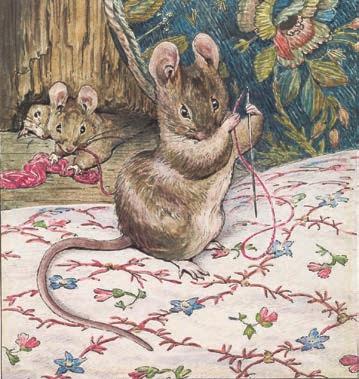
DRAWN TO NATURE:
Beatrix Potter as Gardener, Artist, Author, & Naturalist
LECTURER: Ellen Burke
Wed., April 9, 2025 at 5:30 PM or Thu., April 10, 2025 at 10 AM
France’s Answer to The Monuments Men
LECTURER: Abbe Allen
Thu., April 24, 2025 at 5:30 PM or Fri., April 25, 2025 at 10 AM
COST PER LECTURE:
$26 for Arts Council Members | $32 for Nonmembers Space is limited. All lectures will be presented in Arts Council Galleries at Campbell House (482 East Connecticut Ave., Southern Pines)

Reserve your space now with full payment at the Arts Council or call 910-692-2787
Learn more at www.MooreArt.org/ArtsLectureSeries



Friday, March 7, 5:00-7:00
The Artists League of the Sandhills presents “Abstracted” - an exhibit featuring abstract paintings which have been created in a variety of mediums. The exhibit opens with a public reception on Friday, March 7, from 5-7, and runs through Friday, March 28.
The Artists League is offering a variety of classes that give artists an opportunity to explore abstraction for themselves. Enjoy the art during our reception and then register for a class if you are interested in learning new skills.


Sunday, October 5, 2025 • 1:00-3:00 PM Our Saviour Lutheran Church 1517 Luther Way • Southern Pines, NC

• $10/child admission for children 10-17 Free admission for children 9 & under SPONSORSHIP OPPORTUNITIES AVAILABLE Enjoy a sampling of soups and desserts from area chefs, Live band & 50/50 Raffle

• $50/person with choice of pottery soup bowl to keep • $30/person admission for returning attendees. Limited number available.
Purchase tickets online beginning March 1st at www.sandhillscoalition.org, by mail (1500 W. Indiana Ave Southern Pines, NC 28387), or by calling 910-693-1600




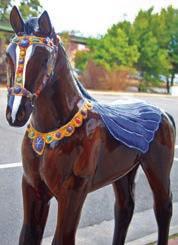


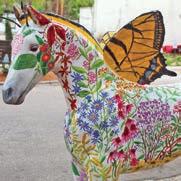
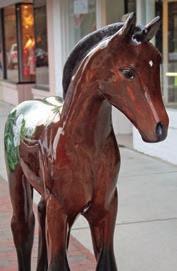
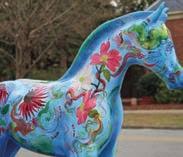
Elks Lodge 1692
A Southern Land Title Agency
Aramark
Bourne Capital Partners, LLC
Brownson Memorial Presbyterian
Casino Guitars
Christ Church Anglican
Clark Cadillac
Coldwell Banker Advantage
County of Moore
The Country Book Shop
Creed & Garner Roofing Co, Inc.
Cooper Ford
Dr. Edward C. Monroe, DDS
Duke Energy
Dynamic Operations Solutions
Elite Roofing, LLC
Elliott’s on Linden
Emmanuel Thrift Shop
Everything Pines Partners
First Bank
First Baptist Church of Southern Pines
First Capital Bank
First Citizens Bank
FirstHealth of the Carolinas
Forest Creek Golf Club
HRT Carts and Parts LLC
Ice Cream Parlor
Jersey Mike’s
Liberty Tire Services, LLC
Lin Hutaff’s Pinehurst Realty Group
McNeill Oil and Propane McPeake Hotels, Inc
sandhillsbgc.org
Meridian Kiosks
Mid-Carolina Regional Association of Realtors
Moore County ABC Board
Mz-Smiths Clean Team, LLC
North State Insurance Advisors
Nature’s Own
Patriots Golf & Social Club
Pine Needles Lodge & Golf Club
Pinehurst Toyota
Pinehurst Resort
Pinehurst United Methodist Church
Pinewild Country Club
Rotary Club of the Sandhills
Sacred Heart Roman Catholic
Sandhills Cinema
Sandhills Community College
Sandhills Pediatrics, Inc.
Southern Pines Brewing Company
Sport Clips
Spot On Floor & Carpet LLC
TempControl, Inc.
The Sophisticated Ladies
The Town of Southern Pines
The Village Chapel
This End Up Furniture
Van Camp, Meacham & Newman, PLLC
Veterans Guardian
Whispering Pines Thrift Shop











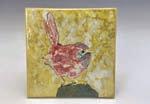








your re ligion?
Historic Clothing of the 1850s
You may be seeking a Faith Community that: embraces diversity and celebrates the inherent worth and dignity of every person, regardless of their race, gender, sexual orientation, age, ability, or background. Find it with us!!
Southern Pines Public Library
January 25, 2025
Photographs by Diane McKay

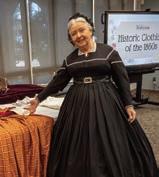
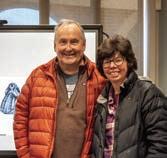




All are Wel come


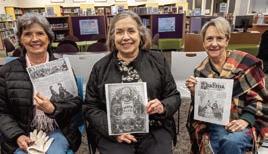
The Unitarian Universalist Congregation of the Sandhills, where open minds and open hearts come together in a spirit of love and respect. Come be a part of a community that encourages personal growth, social justice, and compassion . Join us at 1320 Rays Bridge Road, Whispering Pines every Sunday at 10 AM

Embrace diversity, foster connection, and journey with us toward a more compassionate world. All l
– come as you are, and let's grow together!"

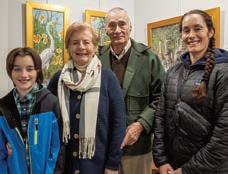


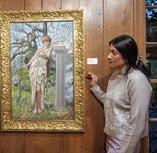













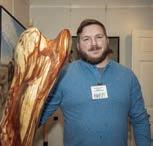


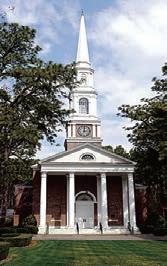
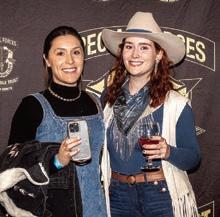

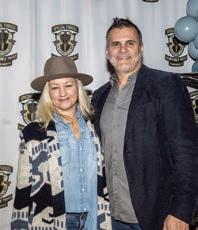
Denim & Diamonds Benefit
Special Forces Charitable Trust
The Fair Barn
January 30, 2025
Photographs by Diane McKay

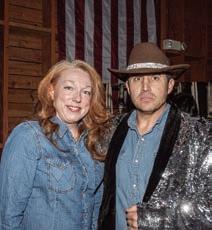
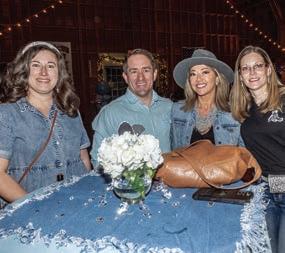
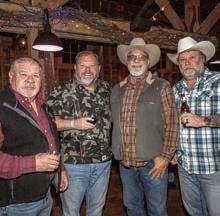




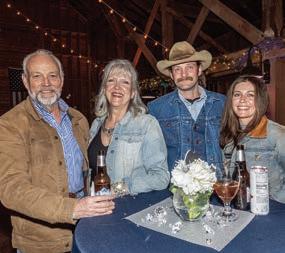












1. Event attended by Cinderella
5. Elliptical
9. Bit of smoke
13. Hawaiian island
14. Cunning
15. Wing related
16. Decree
17. Animal house
18. Barbecue offering
19. Did lab work
21. Put down
23. “___ we having fun yet?”
25. Miner’s find
27. Burned with liquid
29. One to admire (2 wds)
33. “So ___ me!"
34. Ivy League school
35. Author Roald
37. Brothel madams
41. Store convenience, for short
42. Fall
44. Yard tool
45. Crows’ homes
48. Tart
49. Shake up
50. “Tarzan” extra
52. Typical or perfect example
54. Attic’s purpose, often
58. Beige shade
59. Rin Tin ___ , old TV pooch
60. Snare
62. “M*A*S*H” extra
68. “___ Brockovich”
Across 1. Event attended by Cinderella
70. Large lemur
71. “Bye now”
73. Messy dresser
5. Elliptical
74. Copy: Abbr.
9. Bit of smoke
75. Go-___
13. Hawaiian island
14. Cunning
76. Harmony
15. Wing related
77. Monroe’ s successor
16. Decree


17. Animal house
18. Barbecue offering
1. Commanded
19. Did lab work
2. Birds
21. Put down
3. Disaccharide in milk
23. "___ we having fun yet?"
4. Beverage bottle amounts
25. Miner's find
5. Hooter
27. Burned with liquid
6. Lab container
29. One to admire (2 wds)
33. "So ___ me!"
7. Assumed name
34. Ivy league school
8. Ira Gershwin output
35. Author Roald
9. “This means ___!”
37. Brothel madams
10. Homeric epic
41. Store convenience, for short
11. Buffalo hockey player
42. Fall
44. Yard tool
12. Hunted, with“upon,” see 12 down
13. Allow
45. Crows' homes
48. Tart
20. Deceased
49. Shake up
22. Slap on
50. "Tarzan" extra
24. See 12 down
26. A lot
52. Typical or perfect example
28. Grassland
54. Attic's purpose, often
58. Beige shade
29. Blue hue
59. Rin Tin ___ , old TV pooch
76. Harmony


38. Pronoun in a Hemingway title
39. Hand out
77. Monroe's successor
1. Commanded
2. Birds
22. Slap on
40. Adjusts, as a clock
24. See 12 down
26. A lot
43. Puncture
46. _____HEELS!
47. Tiff
3. Disaccharide in milk
30. When repeated, like some shows
60. Snare
31. “___ for the poor”
62. "M.A.S.H" extra
66. One who takes orders, with 56 down
32. Pang
49. Traveled
28. Grassland
29. Blue hue
30. When repeated, like some shows

56. Atop
57. Before the due date
51. Exit
61. Subatomic particle
53. Group of three
54. ___-in-trade
63. Icelandic epic
55. Leg bone
64. Jack-in-the-pulpit, e.g.
56. Atop
65. Puppy bites
57. Before the due date
67. “Baloney!”
61. Subatomic particle
51. Exit
4. Beverage bottle amounts
5. Hooter
6. Lab container
7. Assumed name
31. "___ for the poor"
53. Group of three
32. Pang
54. ___-in-trade
36. Jeweler's glass
69. “ER” network
63. Icelandic epic
64. Jack-in-the-pulpit, e.g.
72. See 56 down (2 wds)
65. Puppy bites
55. Leg bone
36. Jeweler’s glass
66. One who takes orders, with 56 down
68. "___ Brockovich"
70. Large lemur
71. "Bye now"
73. Messy dresser
74. Copy: Abbr.
75. Go-___
8. Ira Gershwin output
9. "This means ___!"
10. Homeric epic
11. Buffalo hockey player
12. Hunted,with"upon", see 12 down
13. Allow
20. Deceased
Fill in the grid so every row, every column and every 3x3 box contain the numbers 1-9.
Puzzle answers on page 115 Mart Dickerson lives in Southern Pines and welcomes suggestions from her fellow puzzle masters. She can be reached at martaroonie@gmail.com.
38. Pronoun in a Hemingway title
39. Hand out
40. Adjusts, as a clock
43. Puncture
46. _____HEELS!
47. Tiff
49. Traveled
67. "Baloney!"
69. "ER" network
72. See 56 down (2 wds)
By Jim moriarty

Games of chance have never been profitable for me. I’m convinced there is a genetic component to the deficiency. My father, who I did not know well, was a non-professional gambler. By this I mean he bet on the horses lavishly but was very bad at it. From what I gather, a lot of bettors study the racing sheet like they’re preparing to take the law boards. My father, on the other hand, was one of those gamblers who bet on a horse because he thought its name was cute or the jockey had just the right shade of blue in his silks. It wasn’t a method that held great promise, and he derived exactly the amount of success from it that you would anticipate.
This carried over to my lone experience betting at the Stoneybrook Steeplechase, that springtime Moore County tradition that was like no other. Since Stoneybrook frequently happened the same week as the Masters, work most often called me to Augusta, Georgia, instead of to the Walsh family farm off Youngs Road. One year, however, the two events diverged, and I was able to attend the races with what seemed like half the state of North Carolina. It was a springtime extravaganza in ways I cannot begin to explain.
Naturally, our tailgating group organized a pool to bet on the races, a practice as common as big hats and cold beer. Given my background, I harbored no illusions of either win, place or show. My expectations were low but were, somehow, exceeded. We drew our numbers from a hat. This alleviated any chance of my putting my father’s methodology to use, which, to be candid, I viewed as something of a plus. I don’t remember
what number I drew but, like everyone else, I bellied up to the rail to watch the start of the race.
Just like that, they were off. A thundering herd. I searched among them for my horse. He must be hidden in the pack, I thought. The earth shook as they pounded past. I doublechecked the number on the slip of paper in my hand. My horse had gone missing.
Confused, I looked back toward the starting line. My horse wasn’t there, either. In fact, he had never gotten beyond it. When the flag went up and the rope dropped, my trusty steed had wheeled in the opposite direction and put a surprising amount of distance between himself and the rest of the horses, until he found a likely spot to jump the fence into the infield, where, presumably, he was meeting friends for a mint julep. My father would have been so proud.
As poor as this wager might have been, it wasn’t my worst gambling faux pas. That came in a Ladbrokes bet shop in the town of St. Andrews, Scotland. The Open Championship was there in 1990. By then Tom Watson was in his 40s and, to be bluntly honest, his championship game had gone to seed. Still, he had very nearly beaten Seve Ballesteros on the old links six years before.
The odds on Watson were 50-1. I thought, how could this not be worth a few quid?
And so I stepped to the window and put down £20 pounds on my sentimental favorite, the eight-time major championship winner. I walked out of the shop in one of St. Andrews’ back alleys into the bright July sunshine, dreaming of what I would buy when my aging ship came in. As luck would have it, at that very moment a sea gull the size of a nuclear submarine flew directly overhead and dropped a load of sewage on me that could have put out a forest fire. Without hesitation, I tore my ticket in half and tossed it into the nearest trash bin.
Watson and I both missed the cut. PS
Jim Moriarty is the Editor of PineStraw and can be reached at jjmpinestraw@gmail.com.







